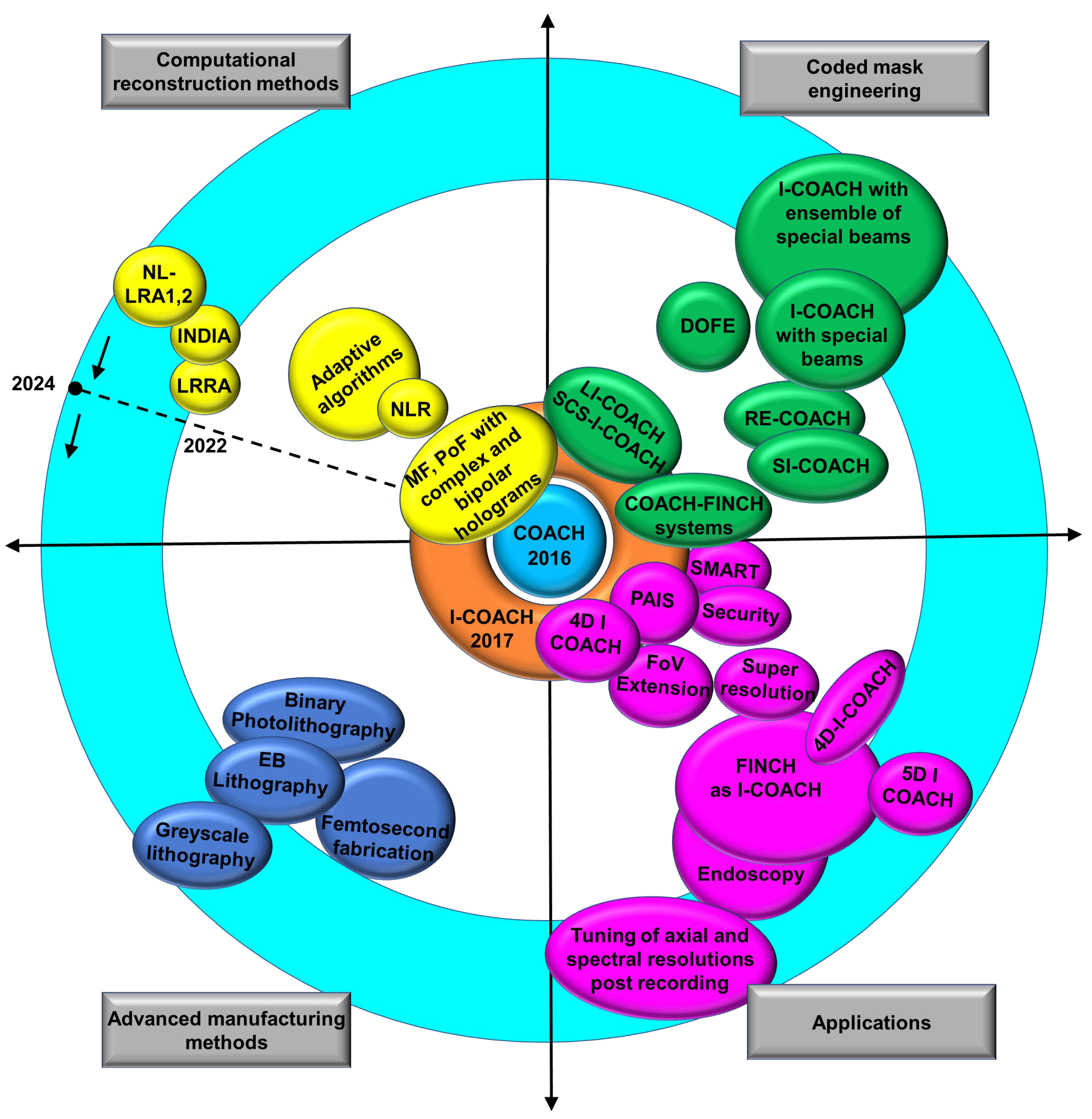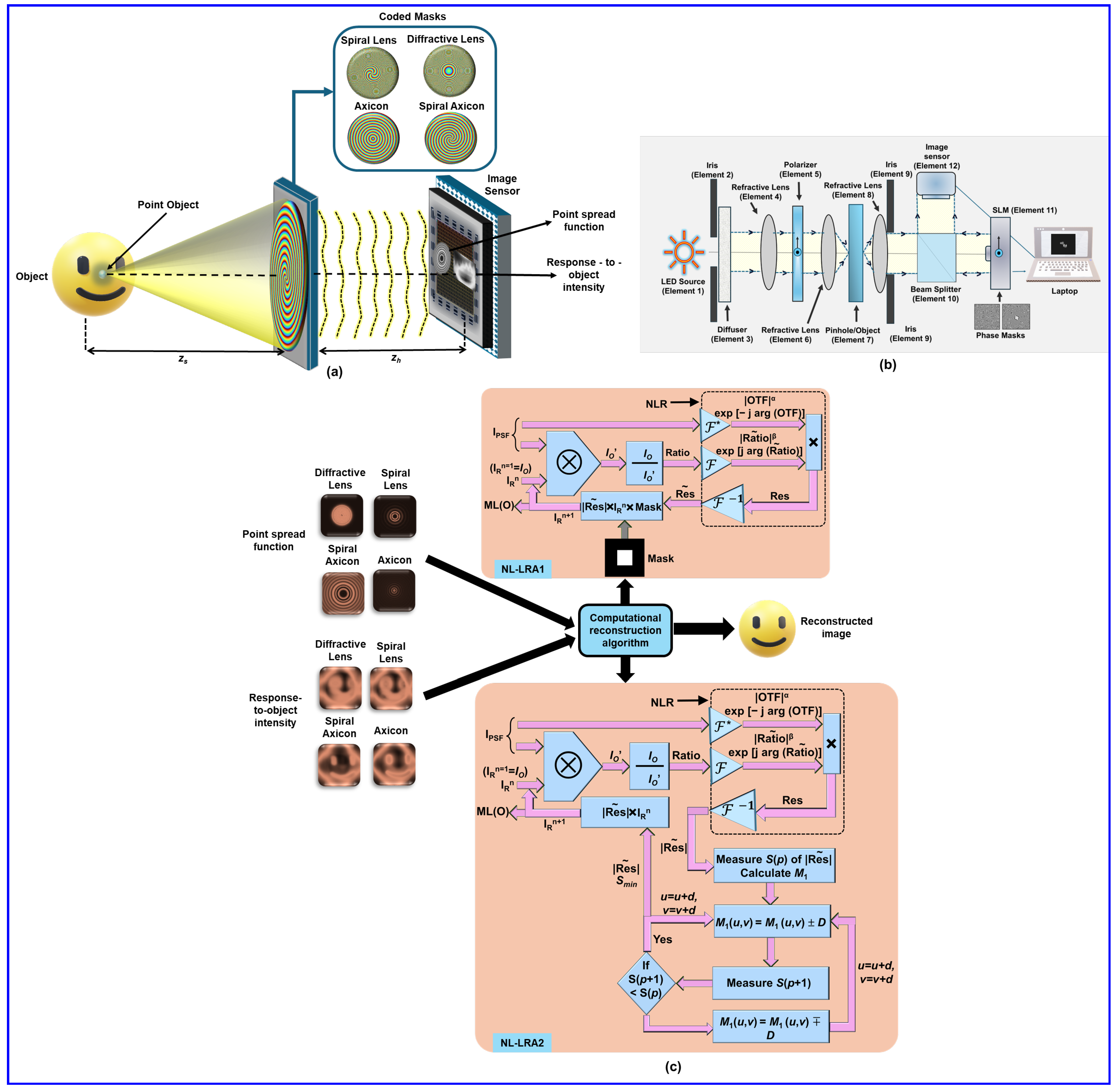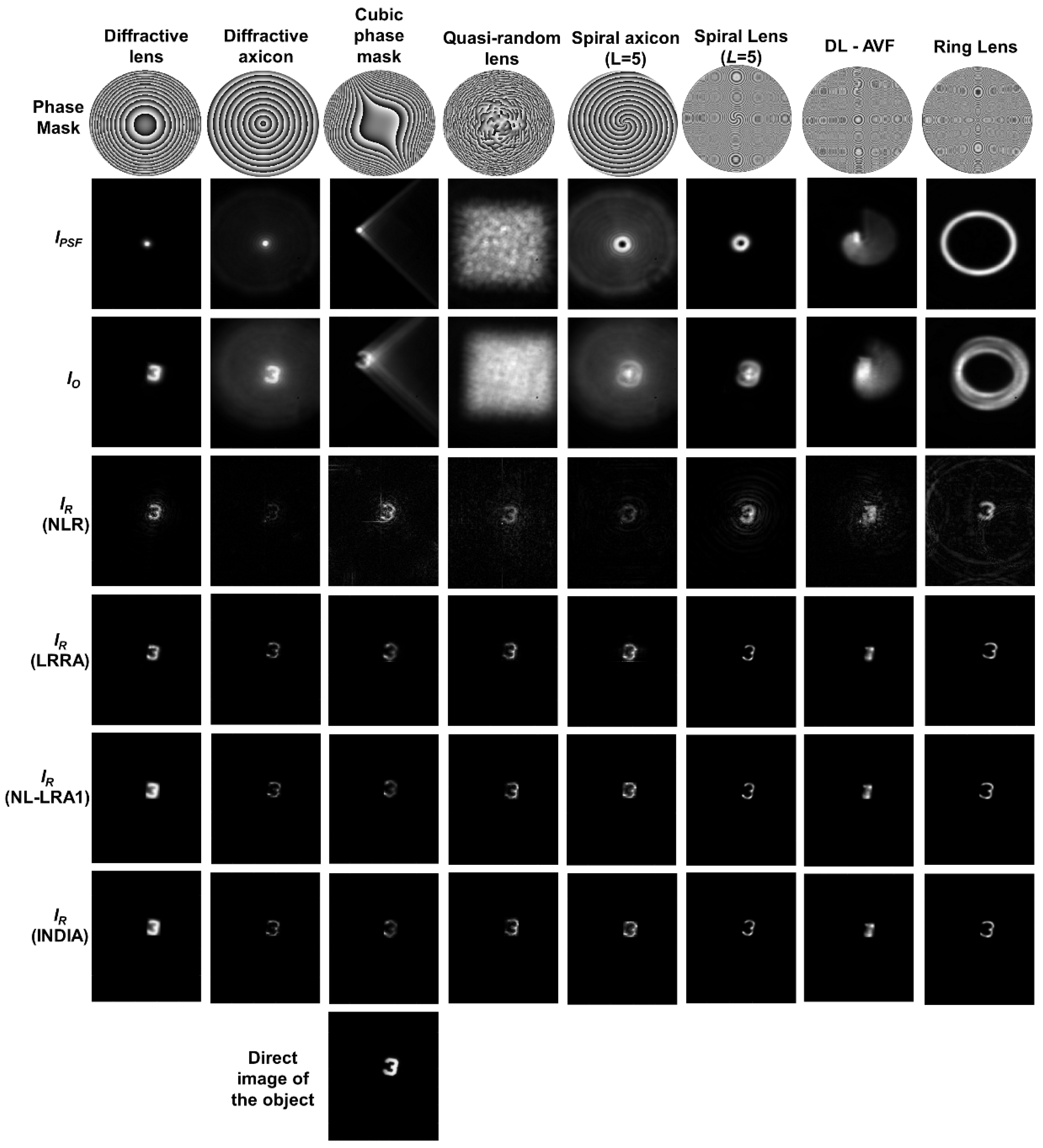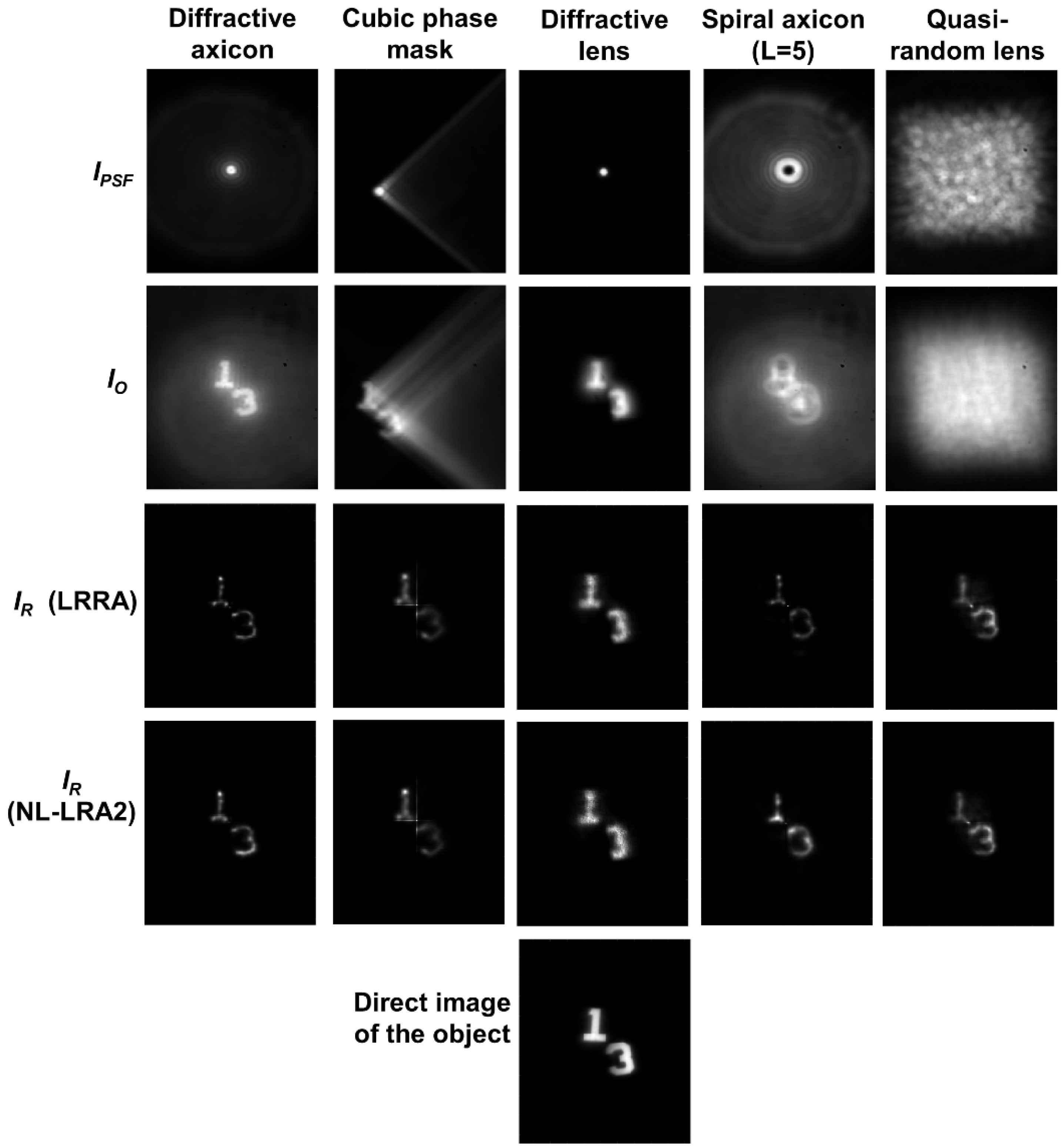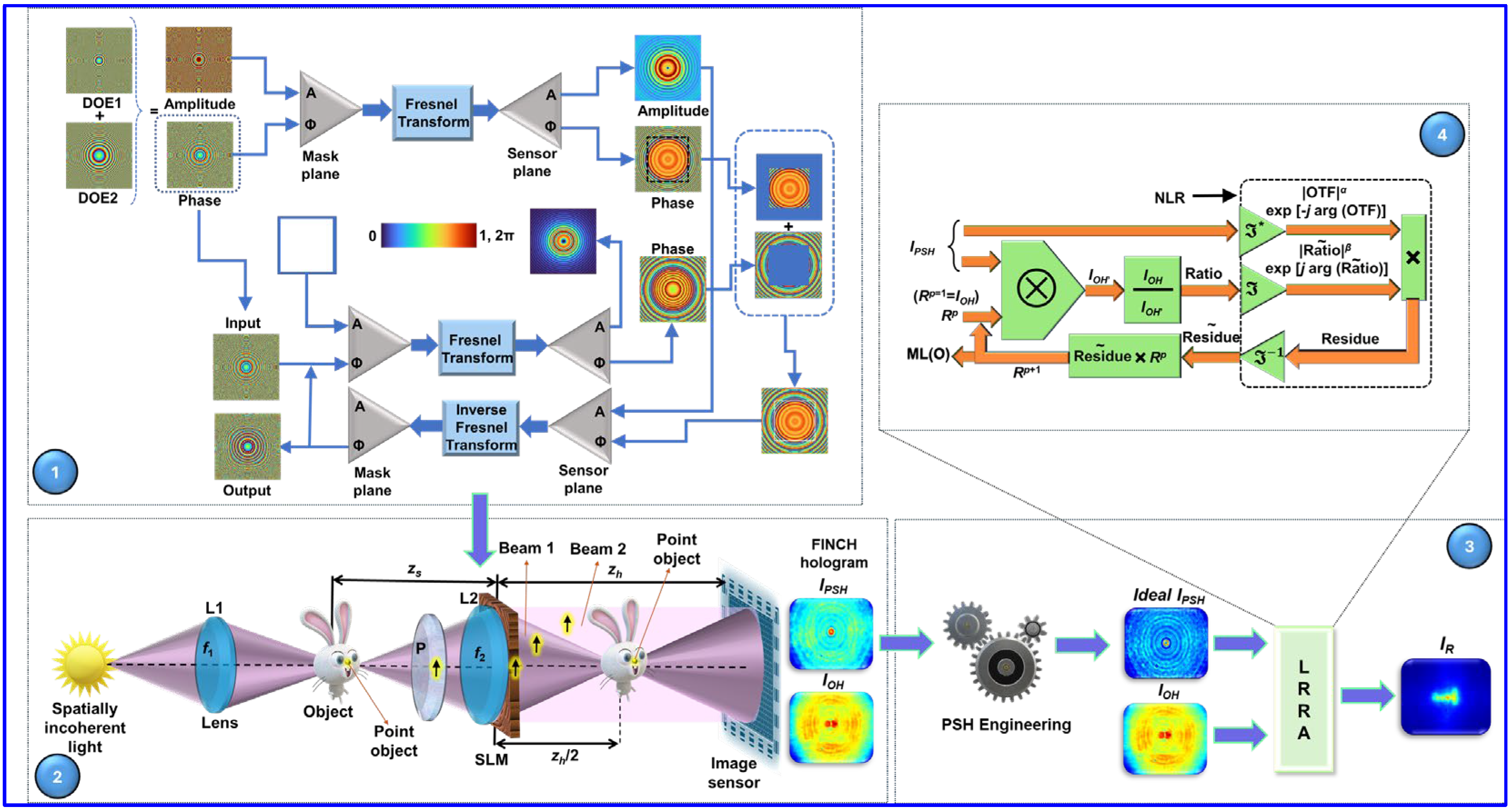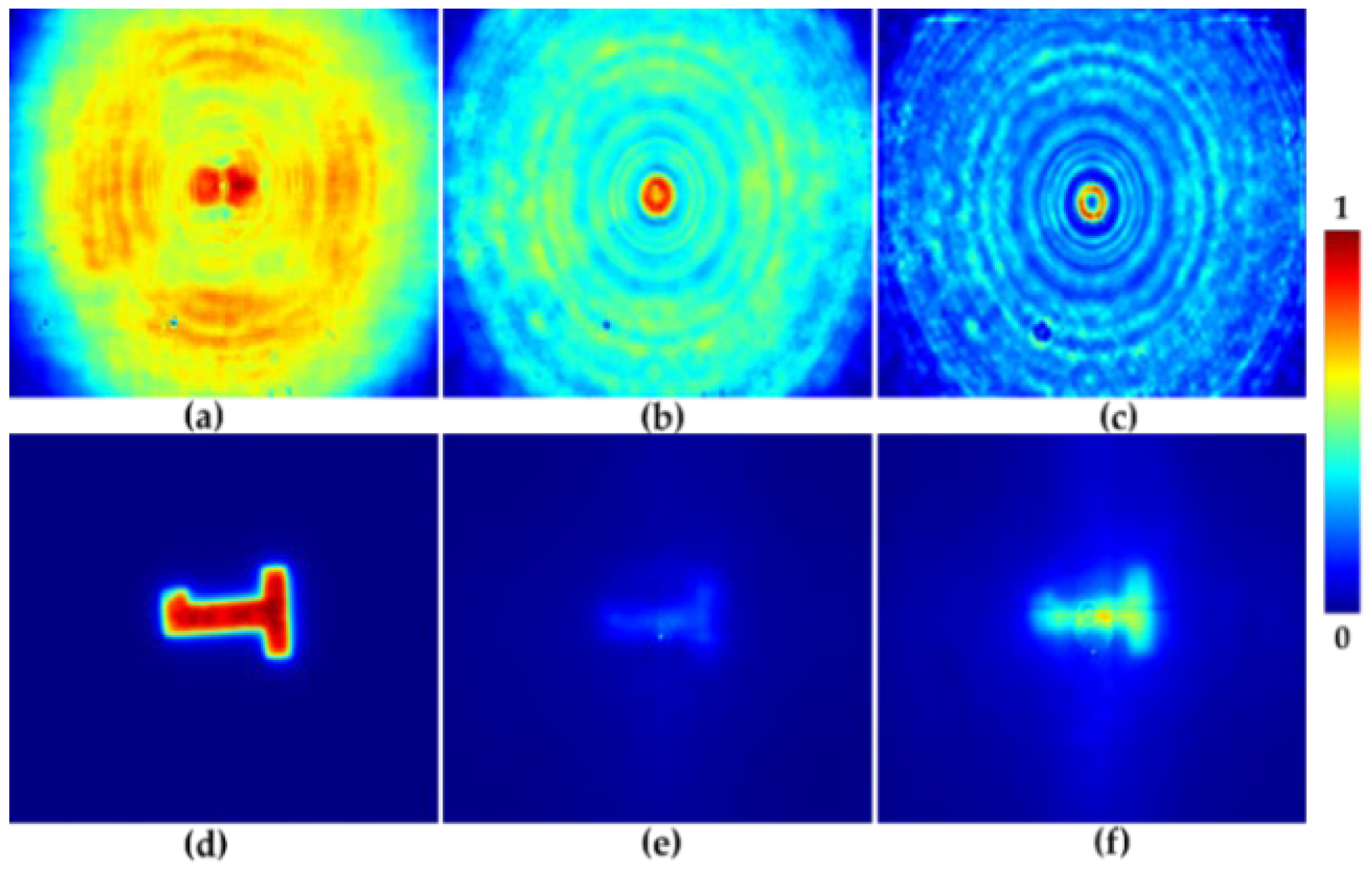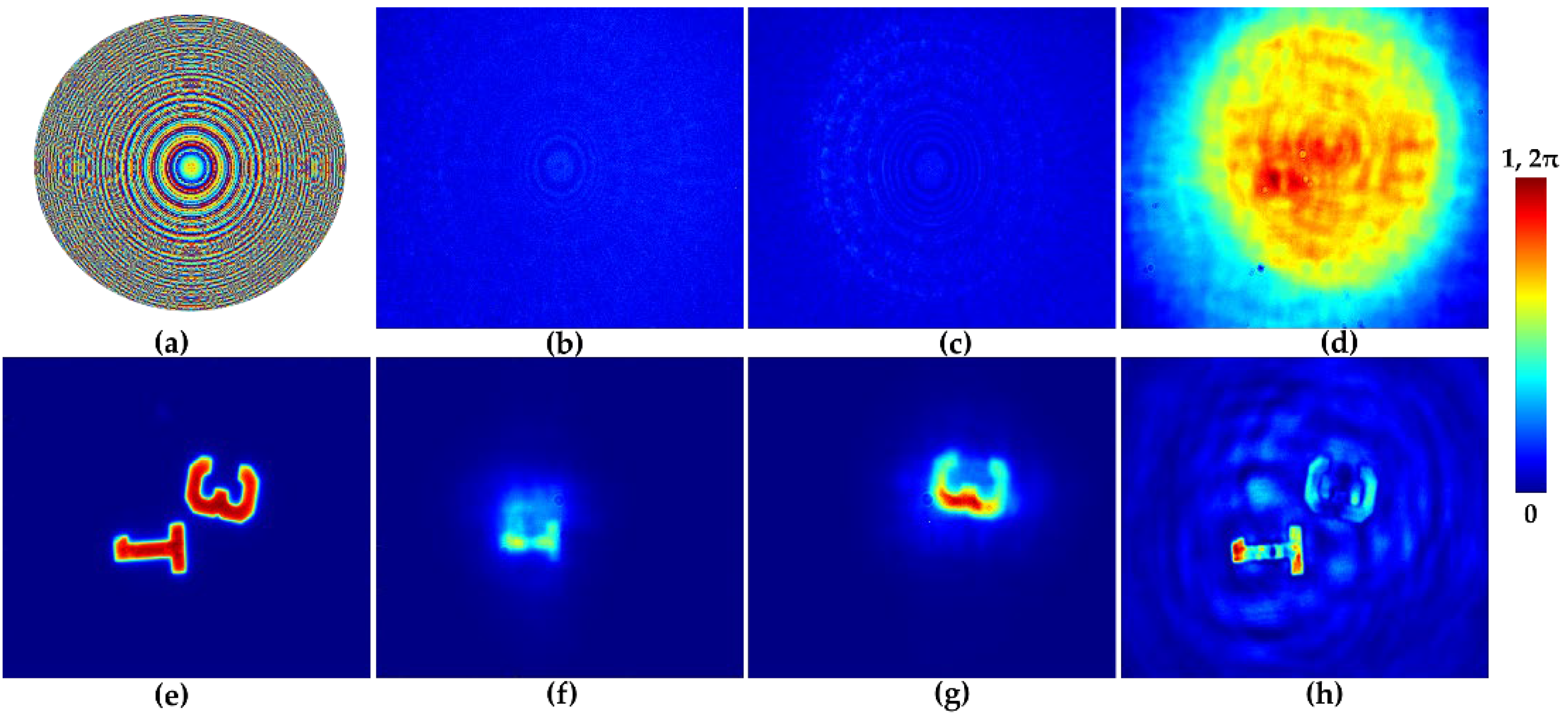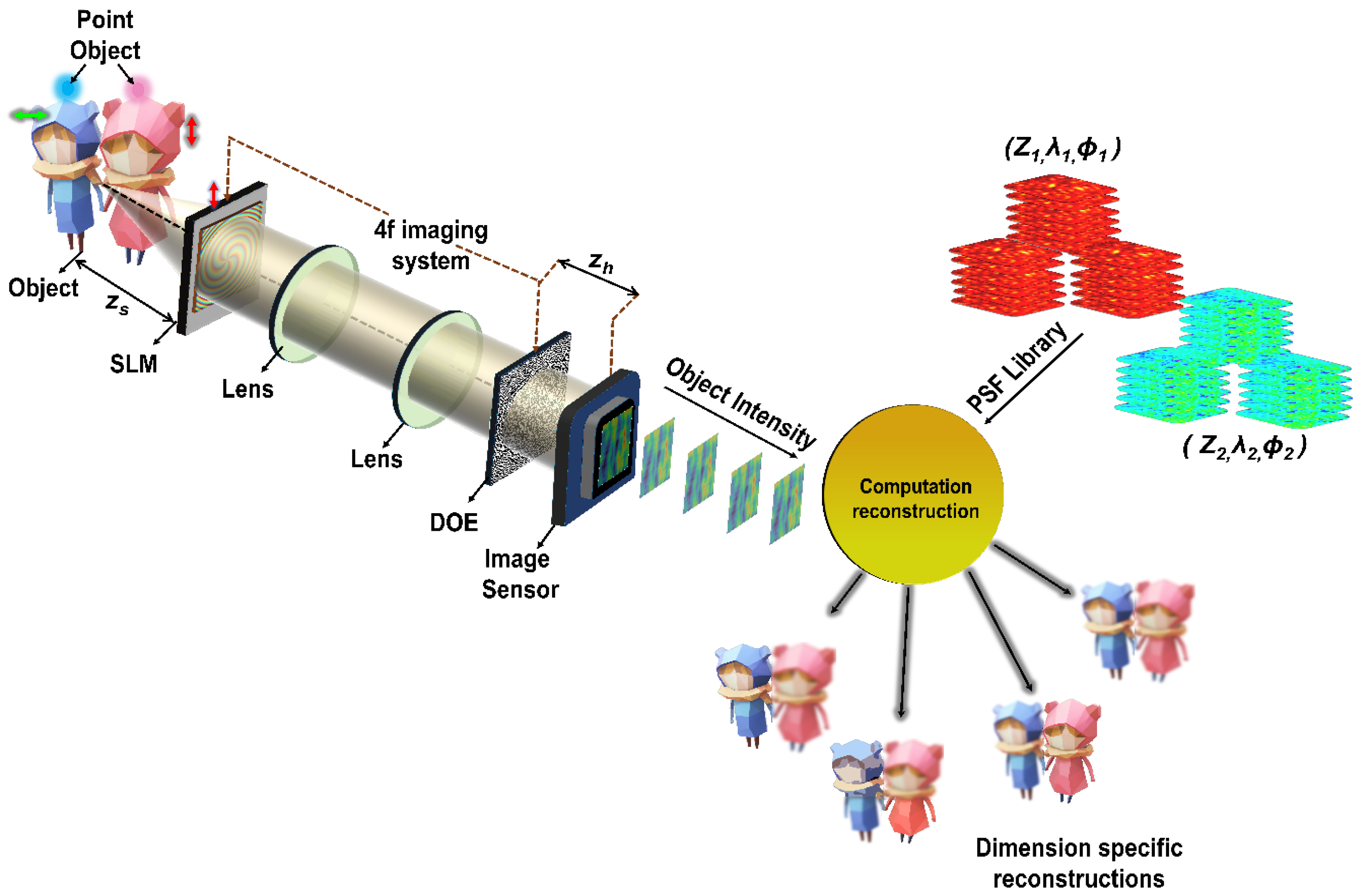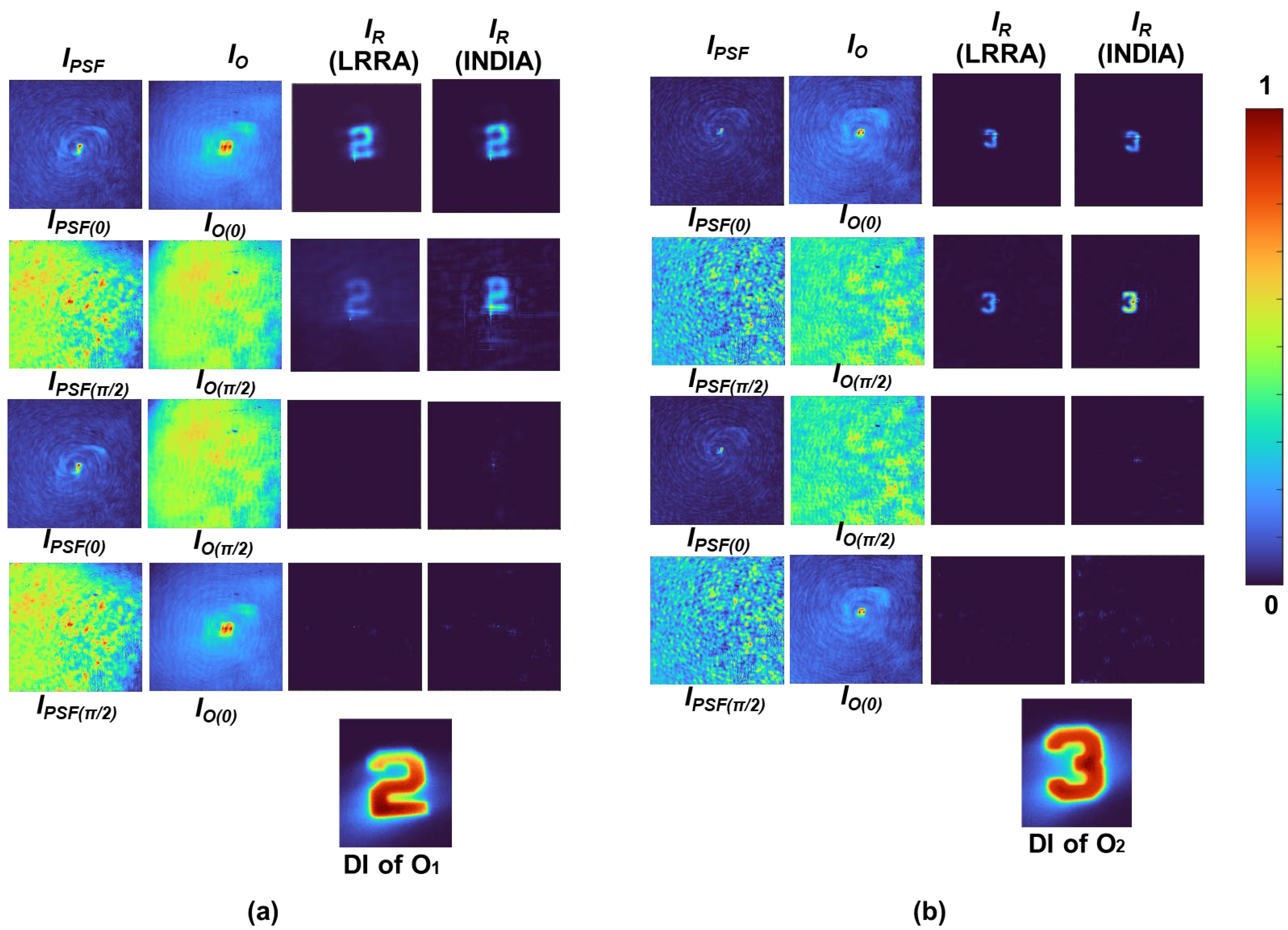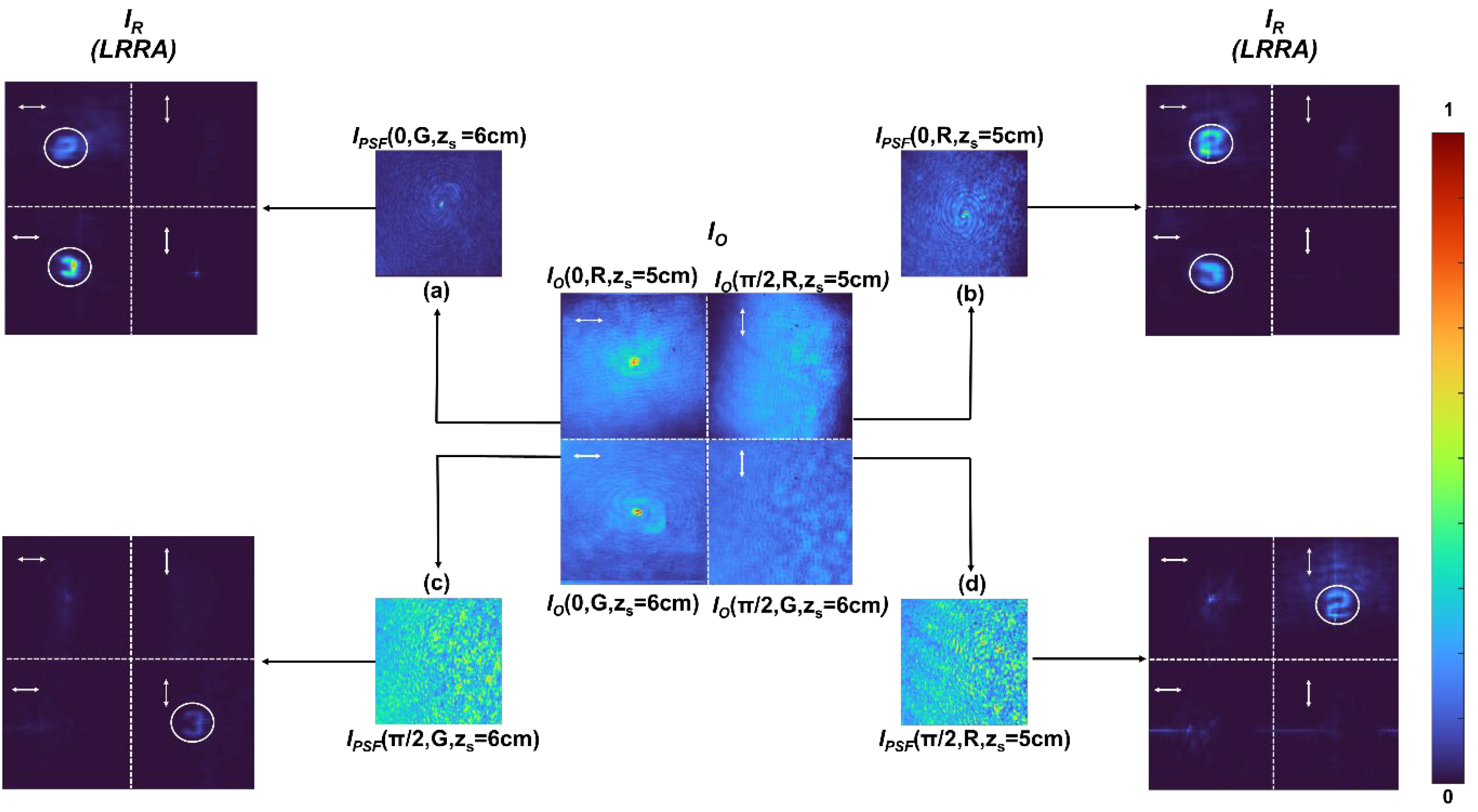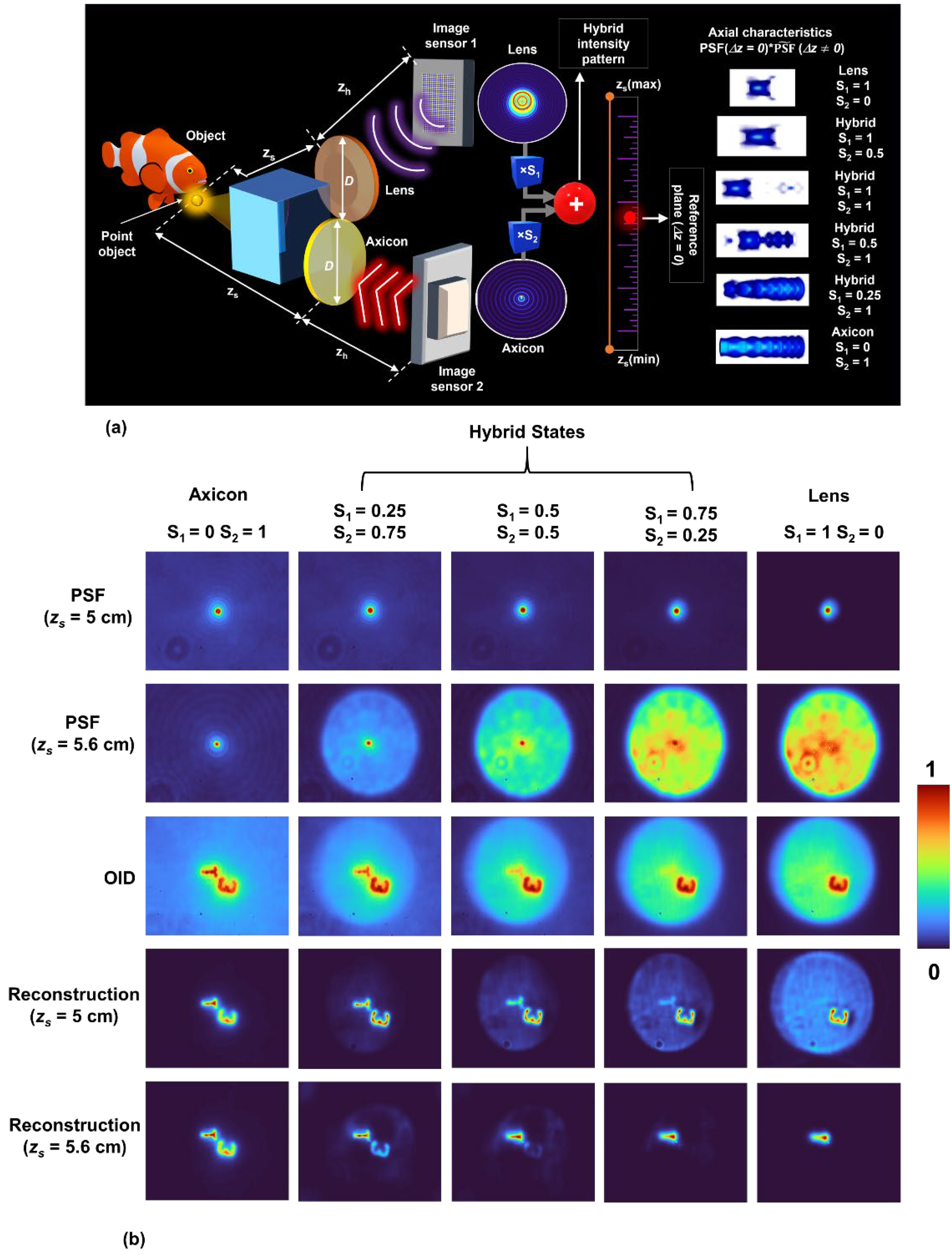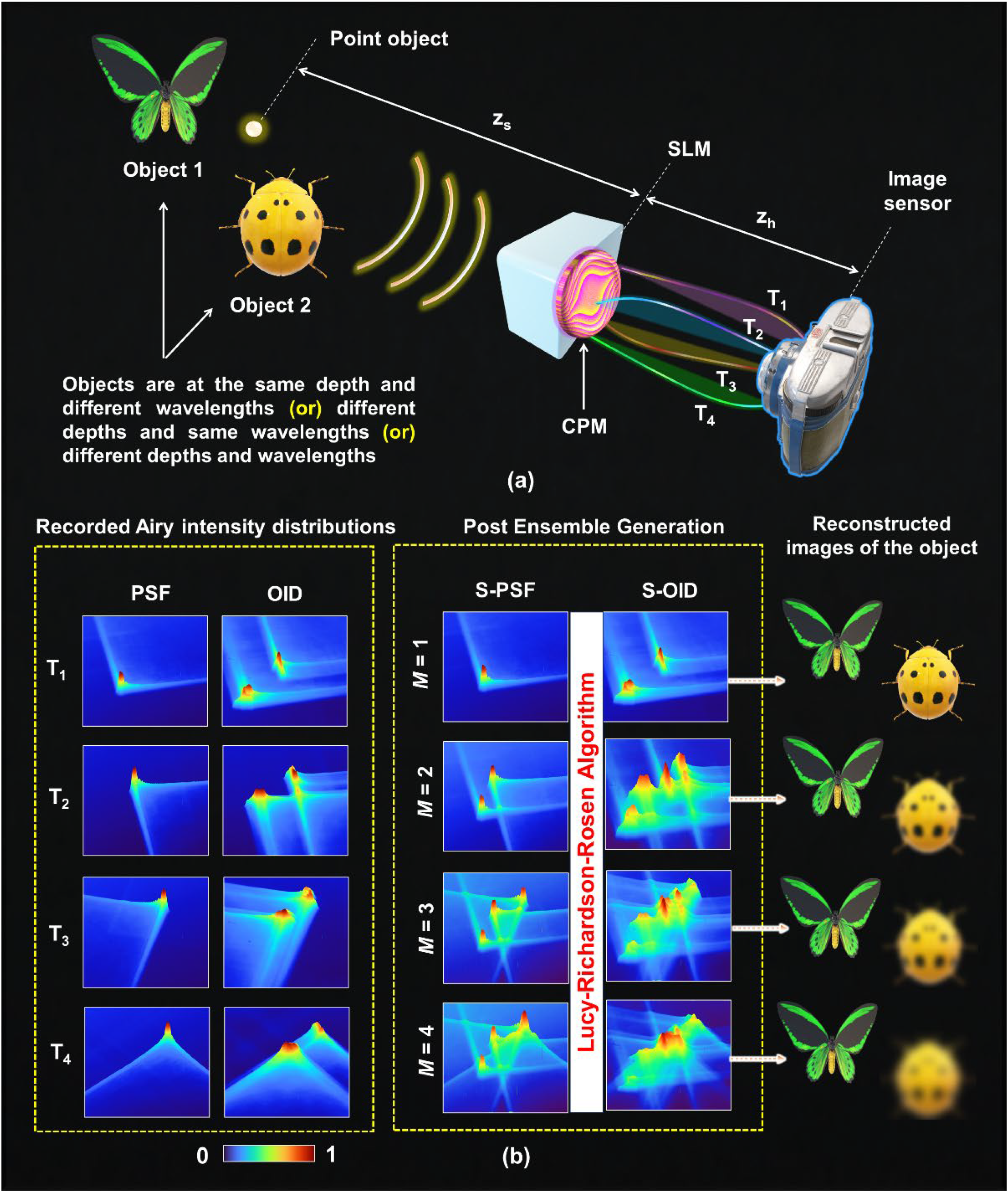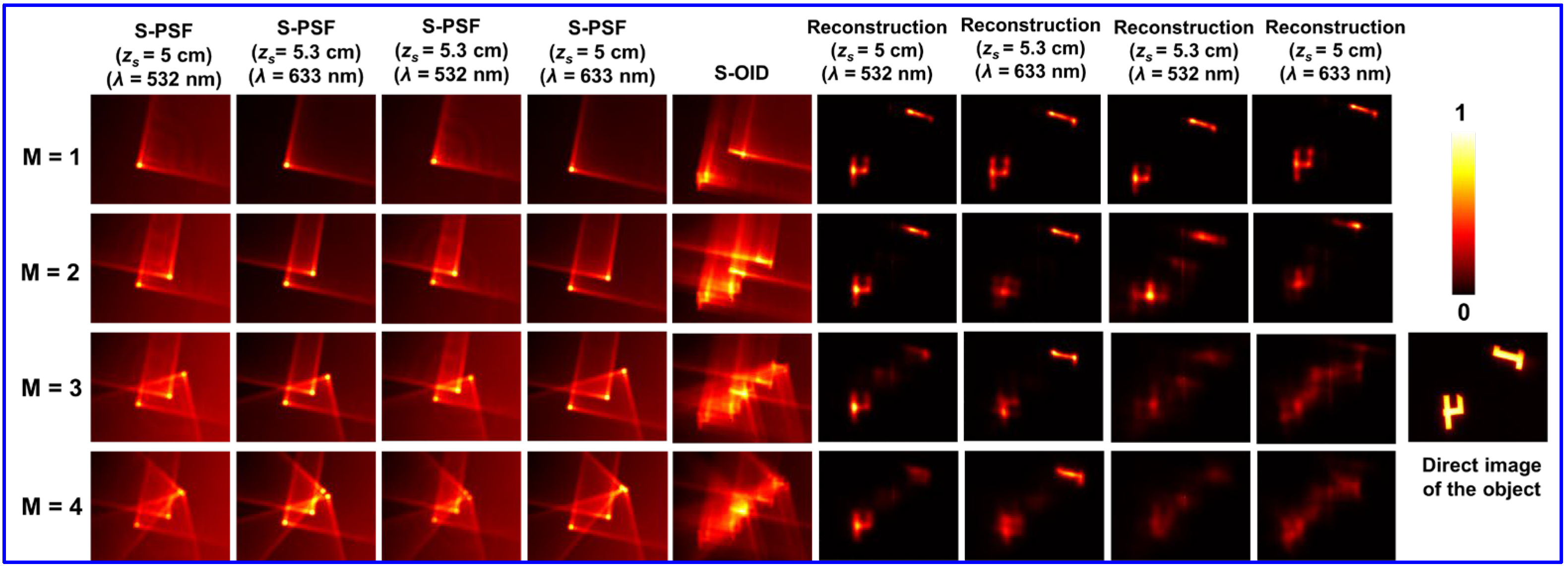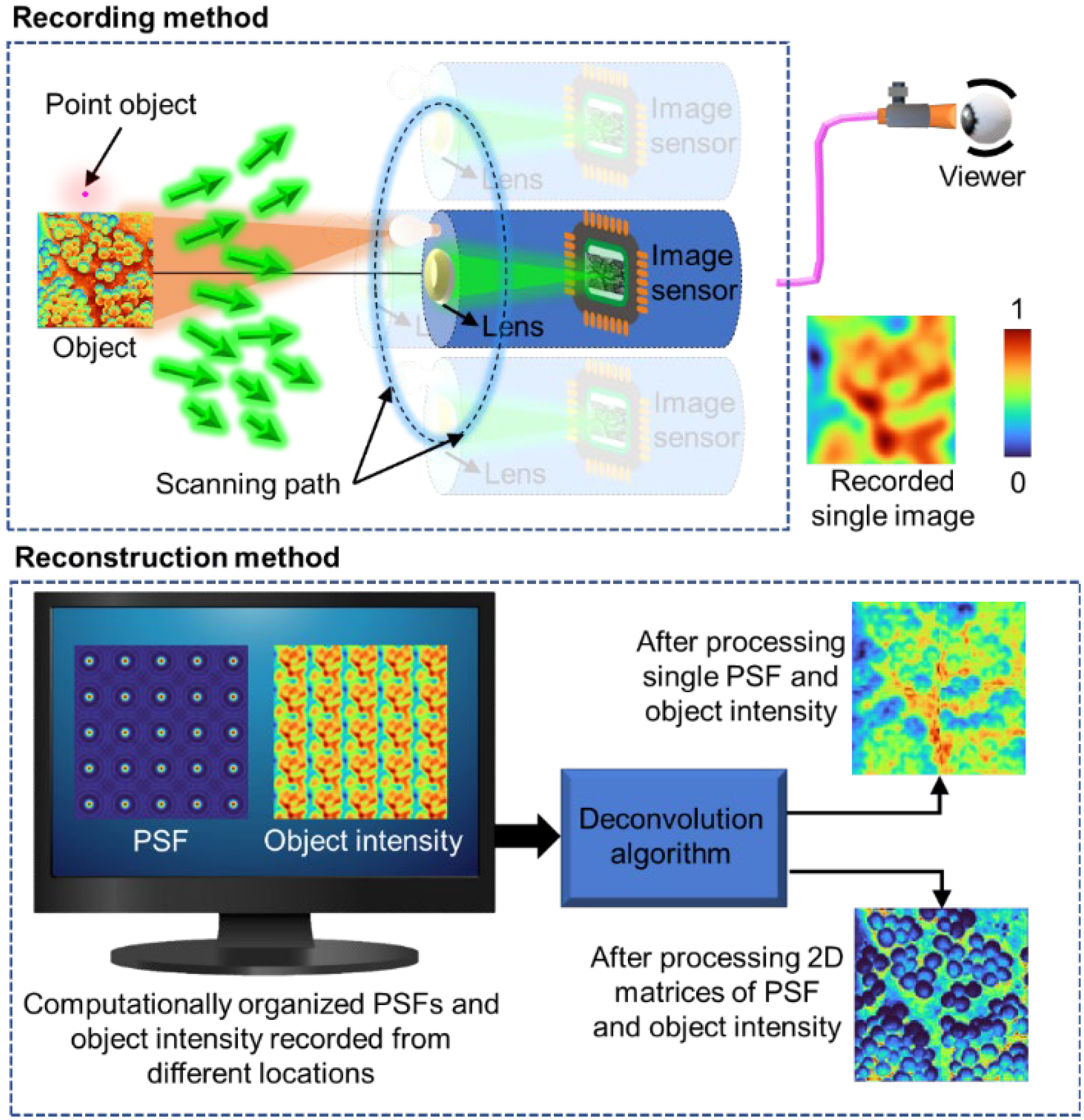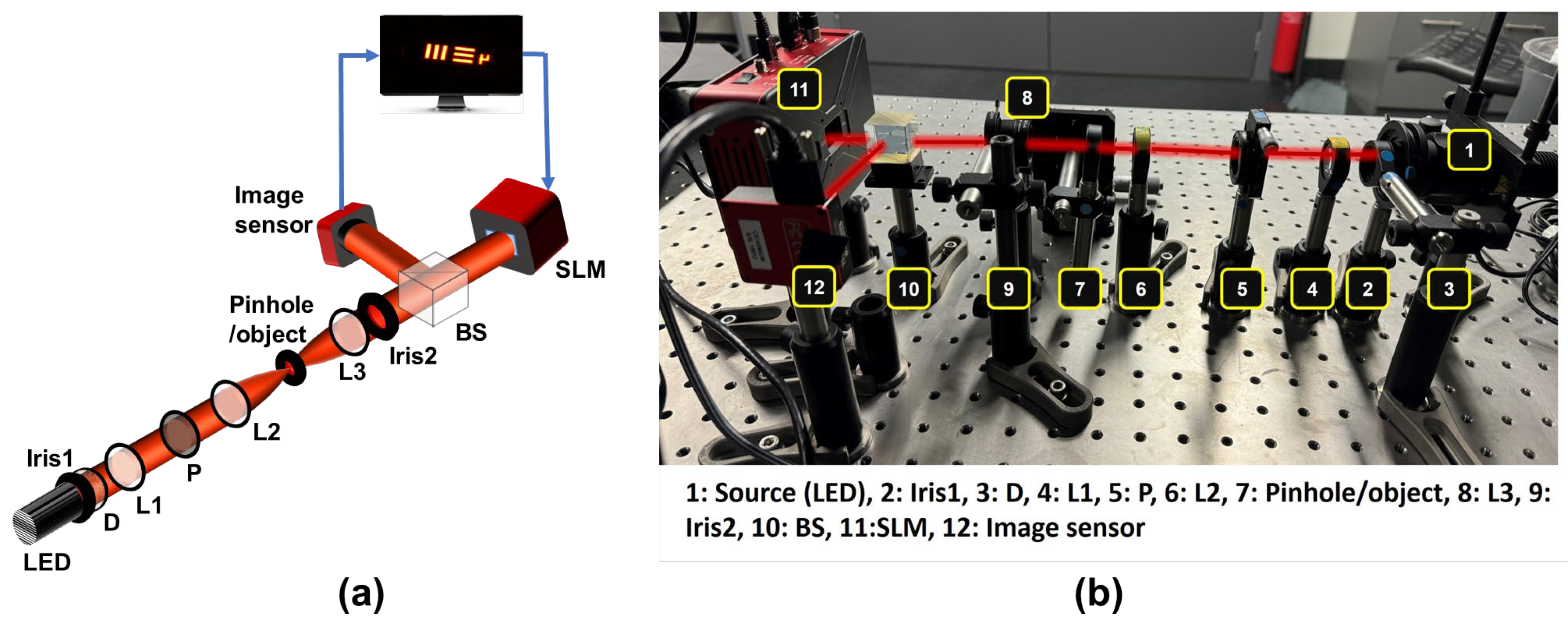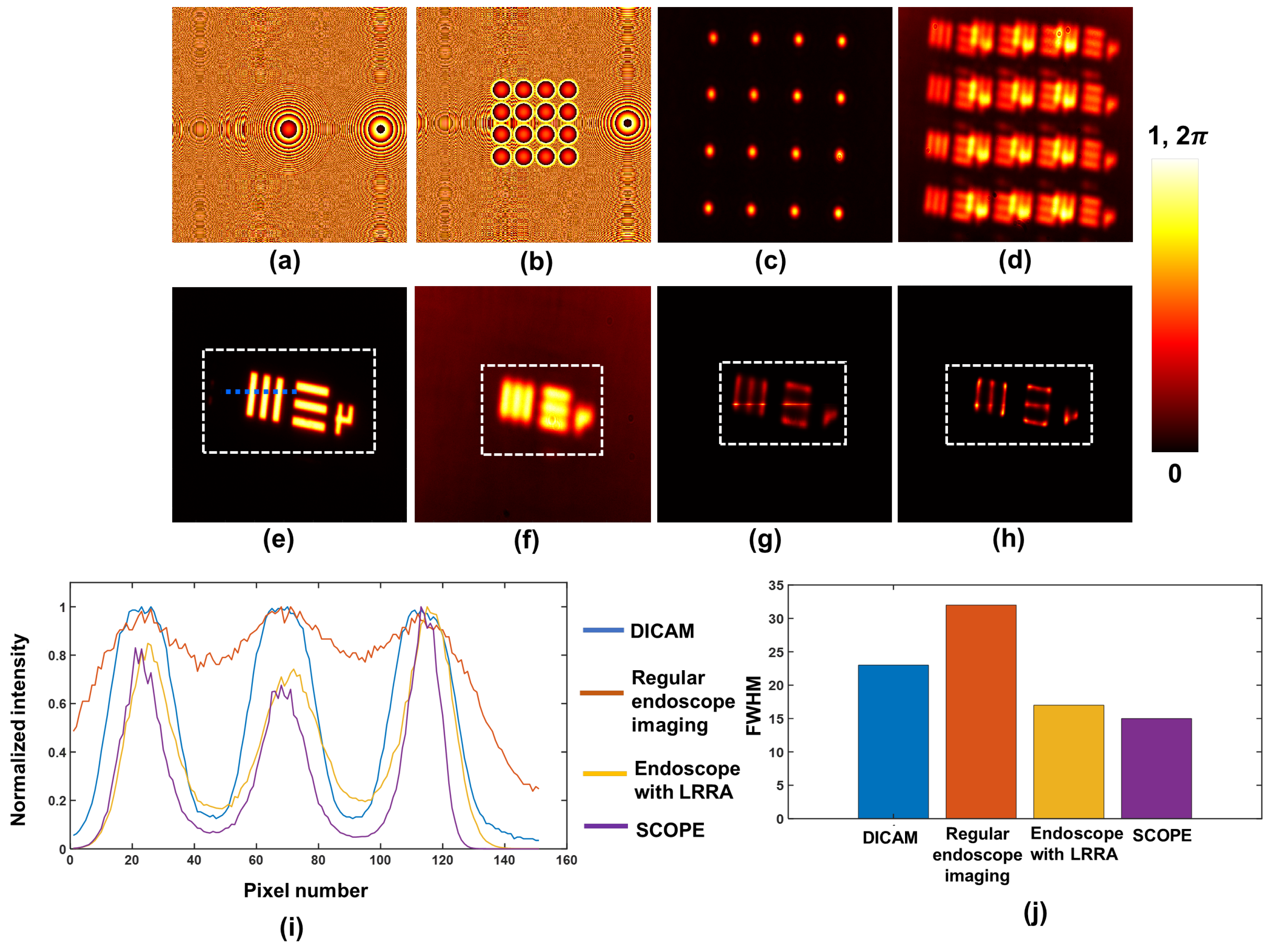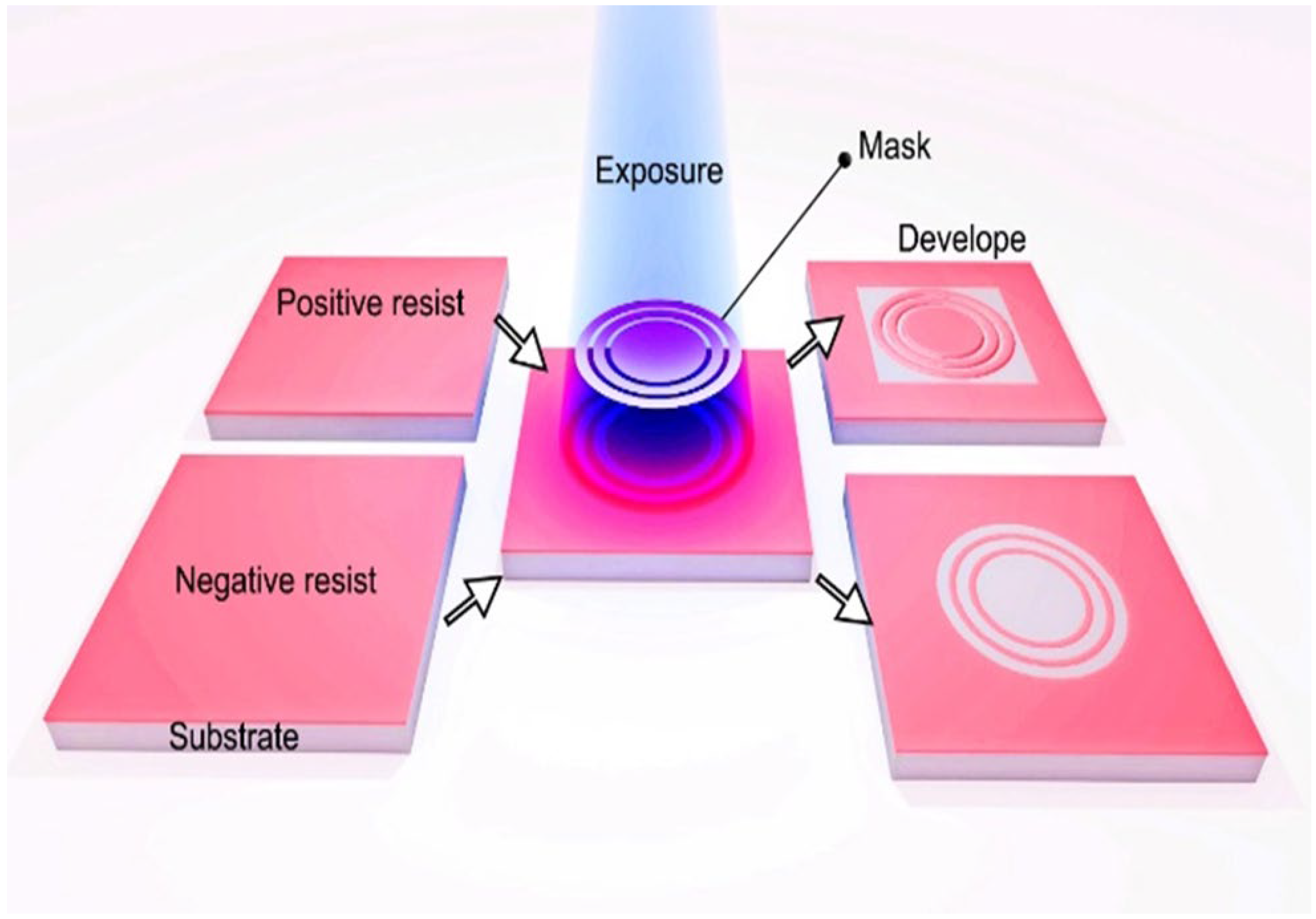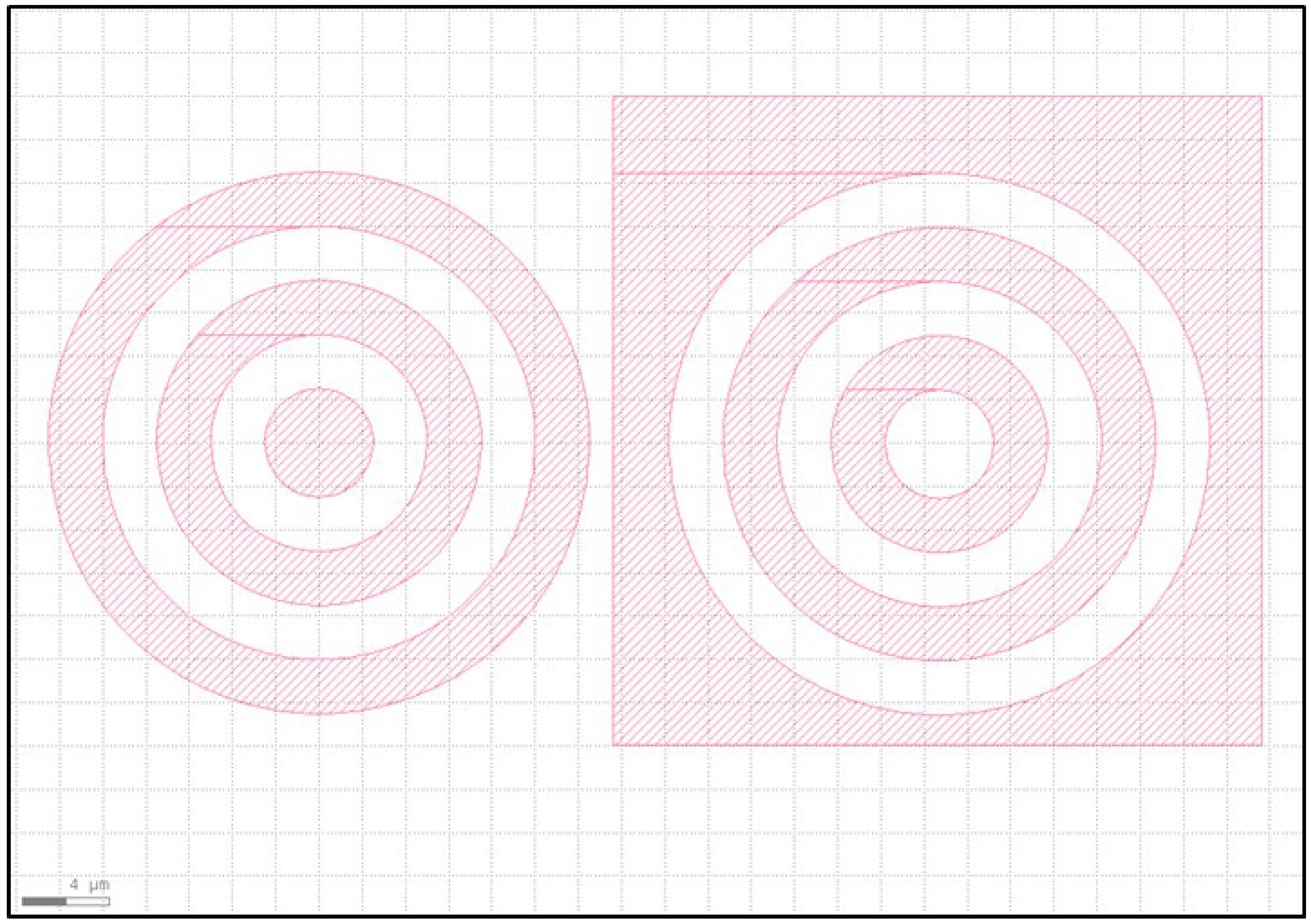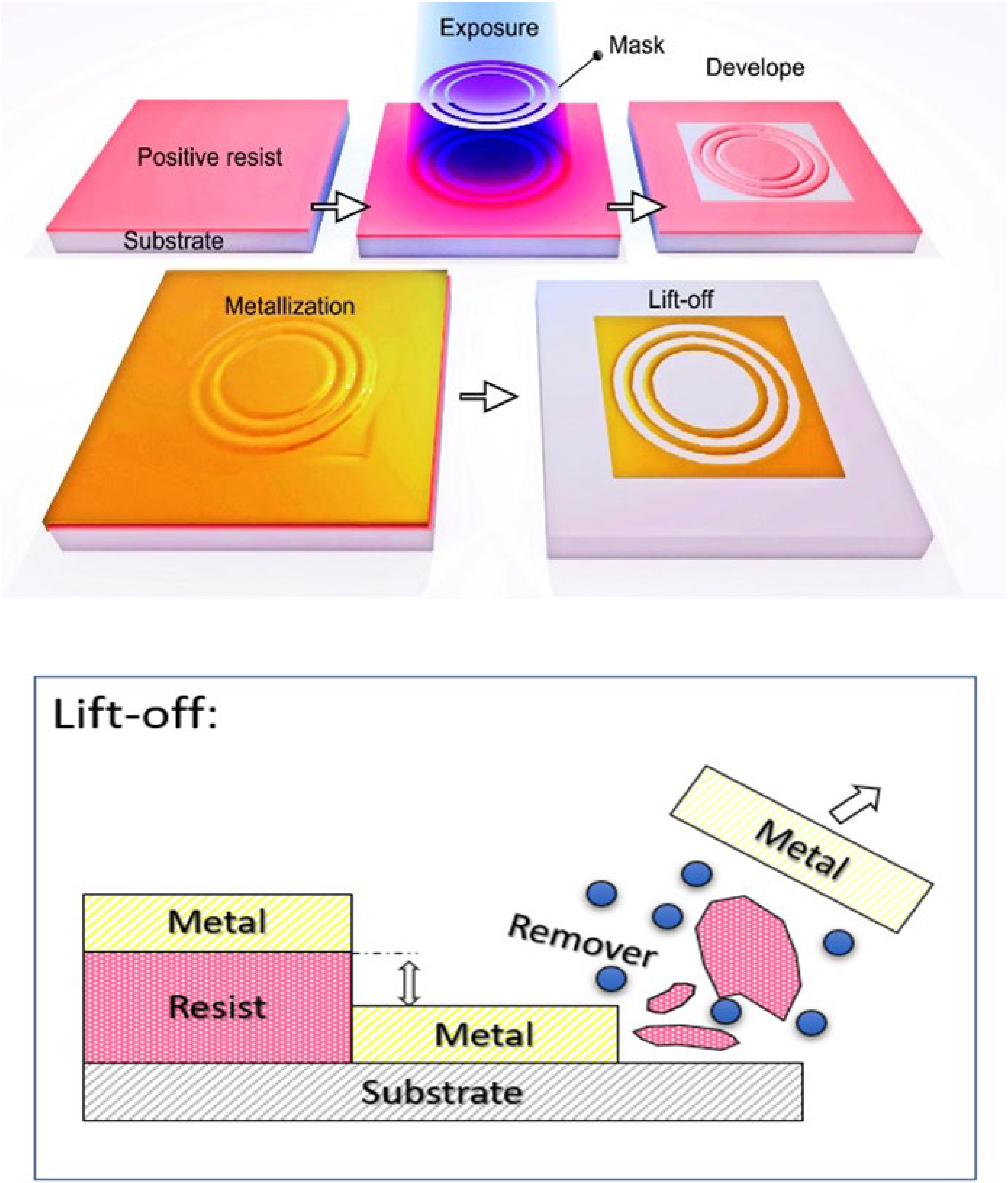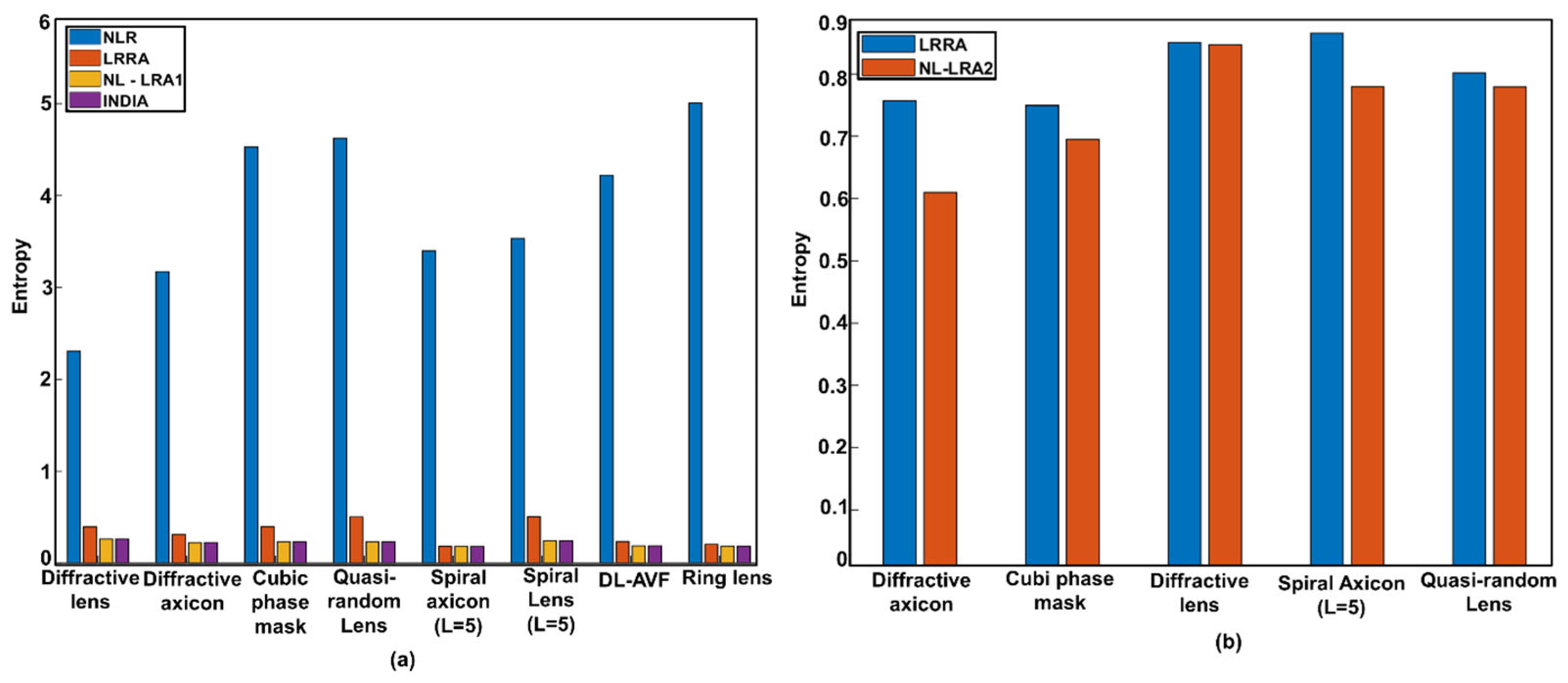1. Introduction
Imaging concepts can be broadly classified into direct and indirect concepts. In direct imaging methods, the imaging process is purely optical, whereas in indirect imaging, the imaging process comprises an optical recording and a computational reconstruction [
1,
2,
3]. Coded aperture imaging (CAI) technology is one of the oldest indirect imaging technologies and was developed during the same time period as digital holography (DH) [
4,
5,
6]. Both CAI and DH were developed to achieve imaging capabilities that are not possible with direct imaging concepts. DH is the digital version of conventional holography where the optical reconstruction is replaced by a computational reconstruction and contains the important advantage of holography, 3D imaging. In this review, we focus on spatially incoherent and temporally coherent sources. Therefore, the information encoded in incoherent DH (IDH) is not phase information, as in the case of spatially coherent sources, but 3D location information [
7,
8]. Therefore, in the IDH, from one or a few camera shots of phase-shifted self-interference holograms followed by a computational reconstruction procedure, 3D location information can be obtained. The computational reconstruction method used in the IDH is analogous to the optical reconstruction method, which involves numerical backpropagation. This 3D information can be expressed as digital refocusing from the perspective of direct imaging concepts, as only optical refocusing is possible in direct imaging. The requirement of the IDH to record phase-shifted self-interference holograms to obtain this digital refocusing feature involves many optical components, vibration isolation systems, and opto-electronic devices, such as spatial light modulators (SLMs) and computational reconstruction methods. In CAI, the main advantage is that, unlike direct imaging methods, a lens is not needed to complete the imaging process. Fabrication techniques and materials for manufacturing in the visible region are well established, and lenses are easily available and low-cost components. However, for other areas of the electromagnetic spectrum, such as X-rays and gamma rays [
4,
5], and even for infrared wavelengths, manufacturing a lens is a complicated process, as fabrication methods are not well established for materials in those spectral regions, resulting in significant costs [
9,
10]. In CAI, light from an object is scattered by a coded mask, recorded, and processed with the point spread function (PSF) recorded using the same coded mask and identical conditions to obtain the 2D image of the object. The requirements of CAI in the optical domain are identical to those of direct imaging, with only a replacement of the lens by a coded mask.
Compared with the IDH and CAI approaches, both approaches involve an optical recording and a computational reconstruction; however, the IDH enables a new feature called digital refocusing, whereas the CAI removes the requirement of the lens to complete the imaging process. The original IDH techniques used for 3D imaging also require lens functions implemented either as a refractive lens or as a diffractive phase mask displayed on an SLM for modulating the light from an object. In 2016, a novel IDH technique called coded aperture correlation holography (COACH) was developed that combines CAI and IDH in a unique way [
11]. In COACH, the optical recording process of IDH and the computational reconstruction method of CAI were applied to allow any coded mask for IDH applications. This development opened new possibilities for IDH, allowing control of the non-linear imaging characteristics of IDH [
12]. The requirements in the optical domain for COACH are the same as those of the IDH in optical components, opto-electronic devices, and vibration isolation systems. In 2017, it was discovered that the amplitude of the object wave diffracted by a coded mask contains the 3D location information of the object. Therefore, two-beam self-interference is not needed to record 3D information. This discovery led to the development of interferenceless COACH (I-COACH) [
13]. I-COACH has all the advantages of the IDH, such as digital refocusing capability, but only the requirements of CAI or direct imaging in the optical domain. Therefore, the development of I-COACH has significantly impacted both the IDH and CAI research areas, resulting in rapid developments in imaging technologies. Developments in the IDH have been periodically reviewed by our team in recent years [
1,
3,
8,
14]. Even though different terminologies, such as I-COACH, COACH, and CAI, have been used, all the above techniques can be unified under CAI, as the characteristics depend on the coded mask, and the reconstruction method of CAI can be applied. In the remainder of the manuscript, the acronym CAI has been used as an umbrella term that includes CAI, I-COACH, COACH, and associated techniques. In this manuscript, we focus on the developments made during the past two years, from 2022 to 2024, in the area of CAI, with an emphasis on recording and reconstruction methods, engineering of coded masks, advanced manufacturing methods, and multidimensional imaging applications. Furthermore, we also identify the techniques developed during the evolution of CAI that are now redundant in this framework. The concept figure is shown in
Figure 1.
One primary research direction of CAI is the engineering of coded masks to improve the performance of CAI and obtain new capabilities. In 2017, lensless I-COACH (LI-COACH) was developed to simplify I-COACH [
15]. In LI-COACH, the coded mask was engineered using the Gerchberg–Saxton algorithm [
16] with Fresnel propagators to create controlled scattering and achieve a high signal-to-noise ratio (SNR) from bipolar holograms obtained from two camera shots. In LI-COACH, there is no additional optical element other than the phase mask, simplifying the configuration of I-COACH. In 2023, LI-COACH was implemented using a binary-coded mask designed using a modified binary search algorithm with an improved SNR [
17]. Lensless CAI methods have been reported by different research groups [
18,
19,
20]. In this research direction, in the same year, single camera shot I-COACH (SCS-I-COACH) was developed, where two uncorrelated quasi-random phase masks with equal and opposite linear phases were embedded in the same coded mask, and two intensity distributions were recorded simultaneously using a single image sensor. In SCS-I-COACH, the field of view (FoV) was sacrificed to achieve single-camera shot capability [
21]. In the same year, in 2017, a conventional IDH technique called Fresnel incoherent correlation holography (FINCH) and COACH were combined to form a hybrid IDH technique that can be tuned between FINCH and COACH. A hybrid-coded mask was engineered by combining the phase masks of FINCH and COACH, and by tuning the ratio, the characteristics of the hybrid IDH can be tuned between non-linear (FINCH) and linear (COACH) imaging characteristics [
12]. The phase mask was engineered to obtain sub-diffraction spots [
22] and sparse dot patterns [
23] that rendered an enhanced imaging resolution and improved the SNR, respectively. All the above research has been reviewed. This review focuses on the latest developments in the engineering of coded masks, which include depth-of-field engineering [
24,
25,
26,
27,
28], spectral resolution engineering [
28], both real-time and post-recording, and improvements in the SNR [
29,
30]. In this direction, SCS-I-COACH is no longer used for research and applications, as all the latest I-COACH methods require a single camera shot.
Another important direction of CAI evolution is the development of computational reconstruction algorithms. At the time of the inventions of COACH and I-COACH, image reconstruction was achieved using matched filter (MF) and phase-only filter (PoF) by cross-correlating the complex object and point object holograms obtained by projecting at least three camera recordings onto the complex space [
31]. In 2018, the non-linear reconstruction (NLR) method was developed, which made single-shot imaging possible in I-COACH [
32]. However, there are numerous deconvolution methods, such as the Lucy–Richardson algorithm (LRA) [
33,
34] and Wiener deconvolution [
35], which can be applied to I-COACH and methods developed specifically for I-COACH by other groups [
36,
37,
38,
39,
40]. In 2022, NLR was implemented within LRA to create the Lucy–Richardson–Rosen algorithm (LRRA), which has a convergence rate two orders faster than that of LRA, with a significantly improved SNR compared with both LRA and NLR [
41]. More recently, two advanced algorithms named incoherent non-linear reconstruction with an iterative algorithm (INDIA) [
42] and non-linear LRA [
43] have been developed to improve the SNR even better than LRRA. Most reconstruction methods, such as LRA, Wiener deconvolution, NLR, and LRRA, have been reviewed thoroughly in our previous studies. In addition, with the development of new methods, previous methods, such as MF, PoF, LRA, and NLR, are no longer used in I-COACH. In this review, the latest methods, such as INDIA and NL-LRA, are discussed.
Another important research direction in CAI is the design and manufacturing of coded masks. From the time of its invention until 2019, I-COACH was implemented using SLM. However, after the development of advanced computational algorithms that allowed single-shot capability, the use of SLM was not needed. Therefore, since 2020, advanced manufacturing methods, such as photolithography, electron beam lithography, and femtosecond fabrication, have been used to manufacture coded masks. This not only reduces the cost but also the overall size of the imaging system. When this possibility was explored, a mask containing a quasi-random array of pinholes (10 cm × 10 cm) was fabricated using the photolithography technique [
44]. Later, electron beam lithography and femtosecond fabrication methods were used for manufacturing small area-coded masks (5 mm × 5 mm) [
45,
46]. The above coded masks were amplitude-only and phase-only two-level elements. Recently, a greyscale photolithography method has been developed, which will be reviewed in this study. This greyscale lithography produces elements with high diffraction efficiency, and the fabrication process is quicker than the electron beam lithography method.
The final direction of CAI evolution involves various applications. It is not an exaggeration that I-COACH revolutionized the field of imaging, as the applications were numerous and diverse, affecting many important imaging technologies. I-COACH has been used to develop multidimensional imaging systems to image simultaneously along 3D space, spectrum, and polarization [
47], partial aperture-based imaging systems [
48] and telescopes [
49], FoV extendable [
50], axial and spectral resolution tunable imaging systems [
27,
28], super-resolution systems [
51], and optical security systems [
52].
The review consists of nine sections.
Section 1 provides an outline of this review article, including significant milestones, recent breakthroughs, and associated applications in CAI. Furthermore, the latest research developments in CAI over the last few years are thoroughly discussed in
Section 2,
Section 3,
Section 4,
Section 5,
Section 6 and
Section 7.
Section 2 elucidates the recent advancements in coded mask design and reconstruction algorithms in CAI. A brief overview of novel deconvolutional algorithms, such as NLR, LRRA, and INDIA, is provided. Furthermore, recently developed computational algorithms, such as NL-LRA-1 and NL-LRA-2, are thoroughly reviewed and demonstrated with simulation and experimental results. In
Section 3, current techniques for implementing FINCH in the CAI framework are reviewed. Furthermore, our recent research, i.e., 5D-I-COACH, which depicts the five-dimensional (5D) imaging capabilities of CAI, along with 3D in space, polarization, and the spectrum, is reviewed in
Section 4.
Section 5 and
Section 6 elaborate on the recently developed methods in CAI for engineering applications. In
Section 5, two novel CAI-based methods, i.e., the incoherent hybrid imaging system (INCHIS) and post-ensemble generation with Airy beams for spatial and spectral switching (PEGASASS), are discussed and demonstrated for engineering the axial and spectral resolutions of an imaging system.
Section 6 encompasses recent advances in CAI-based endoscopy techniques. In particular, our recently developed super-resolution correlating optical endoscopy (SCOPE) method, which involves high-resolution imaging and can be adapted to commercial endoscopy systems, is discussed.
Section 7 is dedicated to fabrication methods in CAI. The diffractive optical element (DOE) fabrication techniques, such as photolithography and direct laser ablation, are reviewed in
Section 7. The emerging trends, challenges, and future prospects in CAI are discussed thoroughly in
Section 8 and
Section 9.
2. Coded Aperture Imaging with Deterministic and Random Optical Fields and Non-Linear Lucy–Richardson Algorithm
Recent advancements in CAI have focused on optimizing coded mask (CM) design and reconstruction algorithms to improve the SNR, using deterministic and random optical fields [
14,
43,
53]. In this section, we reviewed NL-LRA. There are two versions of NL-LRA: NL-LRA1 and NL-LRA2. NL-LRA1, developed for limited support images (LSIs), accelerates the convergence rate of the LRRA by enforcing a mask constraint within the iterative loop of LRRA. Moreover, NL-LRA2 improves noise suppression through entropy reduction, particularly for full-view images (FVIs). Both the NL-LRA1 and NL-LRA2 algorithms were tested in CAI using various CMs. The results of the new methods were compared with those of their parent methods, NLR [
32] and LRRA [
41], and it was confirmed that the new methods offer an improved SNR compared with that of the parent methods. The experimental studies revealed that NL-LRA1 performs well for LSIs and that NL-LRA2 performs well for FVIs. Both algorithms can also be simultaneously applied for LSIs, but not for FVIs.
The optical configuration and the optical setup are illustrated in
Figure 2a,b; the optical setup records two intensity patterns. In the first step, a pinhole is placed at the object plane (Element 7), and the corresponding intensity pattern called the PSF is recorded by the image sensor. In the second step, the pinhole is replaced by the object at the same position, and the response-to-object-intensity (
IO) is recorded. The CM, which can be phase-only (grayscale from 0 to 2π) or binary (0 or π), modulates the wavefront before it reaches the sensor. The object can be reconstructed by processing
IPSF and
IO using one of the deconvolution methods. The (
n + 1)th reconstructed image of LRRA is given as
, where
is defined below and
was defined previously. The symbol ‘
’ refers to the NLR, which is given as
where
A represents the PSF,
B is the response-to-object intensity, and
and
are their Fourier transforms. This non-linear operation provides better contrast and noise suppression than conventional linear deconvolution does. LRRA initializes the solution with
IO, allowing faster convergence.
Schematics of NL-LRA1 and NL-LRA2 are shown in
Figure 2c. From the schematics in NL-LRA1, we can see that a mask is applied to refine the estimation, ensuring rapid convergence with an improvement of 70%. Additionally, NL-LRA2 optimizes the Fourier magnitude constraints and applies entropy minimization using
, where
S quantifies randomness and
ϕ(
u,v) represents the normalized intensity distribution. Minimizing entropy enhances depth reconstruction, contrast, and feature clarity while improving the SNR. By integrating NL-LRA1 and NL-LRA2, the method enhances image reconstruction accuracy, providing superior noise suppression and depth retrieval compared with traditional LRRA [
41,
43].
The experimental setup includes a high-power LED, optical elements such as an iris, diffuser, polarizer, refractive lenses, a beam splitter, SLM, and CMOS image sensor. The LED light was first passed through an iris and diffuser to control illumination, collected by a refractive lens, and polarized and directed to the SLM, where deterministic and random phase masks were displayed. The test object was the USAF Test Target, and a 50 μm pinhole for PSF recording was used. The collimated light passed through the beam splitter onto the SLM, and the resulting intensity patterns,
IPSF, and object intensity
IO were captured for computational reconstruction. The experimental results for 2D imaging of USAF object ‘3’ are presented in
Figure 3. The phase masks of the deterministic and random optical fields are shown in row 1, and their corresponding
IPSF and
IO (
zs = 5 cm) are shown in rows 2 and 3, respectively. The reconstruction results of the NLR, LRRA, NL-LRA1, and INDIA are shown in rows 4 to 7, respectively. As seen from the reconstruction results, the performance of NL-LRA1 is better than that of all the other reconstruction methods. Next, the experimental results with two digits, ‘3’ and ‘1’, are shown in
Figure 4. The recorded
IPSF and
IO for different beams are shown in rows 1 and 2. The reconstruction results using LRRA and NL-LRA2 are shown in rows 3 and 4 of
Figure 4.
As proof of study, we calculated the entropy for 2D and 3D imaging, the results of which are shown in
Figure 5.
Figure 5a shows the entropy plot for the different CMs to quantify the results from all the reconstruction methods discussed [
43]. Additionally, the performance of INDIA is identical to that of NL-LRA1. This is because the noise is not high in NL-LRA1, and the amplitude and phase information of NL-LRA1 are fed as inputs to INDIA. Furthermore, the entropy plot corresponding to
Figure 4 is shown in
Figure 5b. In NL-LRA2, a major advantage is that it can achieve the best results by entropy optimization blindly. However, NL-LRA2 might not benefit from having a shorter execution time because the time gained in reducing the number of iterations in LRRA is almost utilized during entropy optimization. Therefore, the main advantage is the better SNR measured by reduced entropy.
As per the results of our study in both scenarios, in the case with all DOEs, the number of iterations required for NL-LRA1 and NL-LRA2 are comparatively less than that of LRRA. Compared with NLR and LRRA, NL-LRA1 and NL-LRA2 yield results with the lowest entropy. In summary, recent advancements in CAI have focused on optimizing both coded mask design and computational reconstruction algorithms. The introduction of NL-LRA, with its two variations, NL-LRA1 and NL-LRA2, has significantly improved noise suppression and computational efficiency over traditional LRRA methods. Experimental validation demonstrated that NL-LRA achieves higher SNRs, faster convergence, and enhanced reconstruction accuracy, making it a promising approach for 3D imaging and low-light applications. These developments highlight the potential of structured optical fields and advanced deconvolution techniques in expanding the capabilities of CAI.
3. Fresnel Incoherent Correlation Holography Implemented in the Framework of Coded Aperture Imaging
Fresnel incoherent correlation holography (FINCH) is an IDH method based on the self-interference principle, developed for the first time that uses a spatial light modulator for 3D imaging applications. FINCH requires a spatially incoherent light source. In FINCH, the light from every object point is split into two beams, spherical and plane beams, or two spherical beams, and interferes with the formation of self-interference holograms. FINCH requires a minimum of three camera shots of three self-interference holograms with phase shifts θ = 0, 2π/3, and 4π/3. The recorded FINCH holograms are projected into the complex space to obtain a complex hologram, which is then numerically backpropagated to reconstruct the object information without the twin image and bias terms. The first version of FINCH, as described in [
54], inherently has superior lateral resolution. However, FINCH has lower axial and temporal resolutions, light throughput, and SNR than direct imaging does. FINCH was later applied to realize a fluorescence 3D holographic microscope [
55]. The advancements of FINCH are presented next. The super-resolution capability of FINCH was achieved with perfect beam overlap at the image sensor [
56], resulting in an enhanced resolving power with the same numerical aperture (NA). In FINCH, resolution enhancement is achieved by shaping the modulation transfer function (MTF) within the spatial frequency limits set by the NA [
57]. In contrast, the structured illumination (SI) approach modifies the bandwidth of the MTF [
58]. In a direct incoherent imaging system, the MTF has a high response for low spatial frequencies and a low response for high spatial frequencies. The MTF of FINCH at optimal operating conditions has a uniform response for all spatial frequencies [
57]. However, the MTF of the SI is expanded such that it retains the characteristics of the direct imaging MTF, which hinders the full potential of the SI. Since FINCH possesses an optimal MTF, it can be utilized as a base imaging system [
8]; this can be used as a platform for applying other super-resolution technologies, such as SI [
51,
59]. To enhance the temporal resolution, spatial multiplexing approaches were used, as in [
60,
61], at the cost of a lower FOV. The polarization multiplexing technique presented in [
62] simultaneously captures holograms for phase shifts of 0, π/2, π, and 3π/2, resulting in a high temporal resolution but a low SNR, and there is a need for a polarization-sensitive image sensor. FINCH, based on a bifocal lens, was reported for point objects [
63]. Further advancements in FINCH are presented in [
1,
7,
8].
Later, COACH was developed and reported to have improved axial resolution [
11] compared with FINCH. In COACH, interference occurs between object beams that are diffracted from the same object point, wherein they are made to pass through a quasi-random CPM, and
IOHS are recorded for phase shifts
θ = 0°, 120°, and 240°. Similarly,
IPSHS are recorded for identical conditions. The reconstruction was carried out by cross-correlating the
IPSH with the
IOH. Later, the NLR was developed to improve the SNR of the reconstruction [
32]. FINCH was combined with the NLR, enabling single-shot capability, with a one-time recorded
IPSH reconstructed object image for the recorded
IOH at the same axial location [
64].
In our research presented in [
65] we implemented FINCH in the CAI framework with three recently developed computational methods, namely, the transport of amplitude into phase based on the Gerchberg–Saxton algorithm (TAP-GSA), LRRA, and computational point spread function engineering (CPSFE) techniques. The TAP-GSA is a recently developed algorithm [
66] for designing phase masks, wherein two or more pure phase functions are combined, forming a complex function. The magnitude of this complex function is transferred into the phase to obtain a phase-only function that is equivalent to a complex function with high light throughput. LRRA is a computational reconstruction algorithm [
41] that is proven to reconstruct images with a higher SNR than the NLR and is therefore used in this study. The CPSFE technique enables the lateral resolution limit to be shifted from the pinhole size to the limit determined by the NA of the imaging system. Additionally, the inherent problems in CAI in recording
IPSH are solved through this approach. If the recorded
IPSH is smaller than the diffraction-limited spot size imposed by the NA, there is no problem. However, a small pinhole allows only a few photons, so the recorded intensity level drops close to the noise level of the image sensor. Therefore, in most imaging systems, a pinhole much larger than the diffraction-limited spot size imposed by the NA is used, resulting in a lower system resolution. Therefore, with the help of CPSFEs, an ideal
IPSH is engineered that can resolve features beyond the size of the pinhole. The proposed FINCH as CAI with three computational algorithms, in addition to solving all the above-mentioned problems of FINCH, can be implemented with a passive diffractive element, excluding the need for a vibration isolation system and additional optical components.
The optical configuration of FINCH as a CAI is presented in
Figure 6. In this study, the phase masks consisting of two diffractive lenses were designed using TAP-GSA with degrees of freedom (DoF) of 98%, where DoF is the measure of number of pixels replaced in the phase matrix to the total number of pixels in the matrix as shown in sub-image 1 of
Figure 6 [
65]. The light from the object point is split into two beams, which are differently modulated using phase masks designed using TAP-GSA displayed on the SLM. The two beams are then interfered with to form a self-interference hologram. The
IPSH and
IOH are recorded one after the other by replacing the point object (pinhole) with a test object, as shown in sub-image 2 in
Figure 6. The reconstructed object (
IR) with LRRA is given as
, where ‘
’ represents the LRRA operator with optimal values of
α,
β, and
i, where
α and β are the powers of the magnitudes of the spectrum of the matrices, and
i is the number of iterations. The object reconstructed via LRRA possesses improved resolution and SNR.
The experiment used for this study was adapted from [
65]. To push the resolution limit to the limit set by the NA, an ideal
IPSH is engineered using the CPSFE technique, as shown in
Figure 6. The ideal
IPSH is the point spread hologram estimated from the
IPSH recorded using a pinhole with a diameter larger than the diffraction-limited point size. In CPSFE, the recorded
IPSH and direct image of the 50 μm pinhole are processed using LRRA to engineer the ideal
IPSH. The ideal
IPSH is engineered using CPSFE and is given as
, where ‘
’ represents the LRRA operator,
IPSH_recorded is the point spread hologram recorded for a larger pinhole size, and
Ip is the direct image of the pinhole. From the engineered ideal
IPSH and recorded
IOH, the object image is reconstructed. The phase masks designed using TAP-GSA are displayed on the SLM, and the recorded
IOH and
IPSH are shown in
Figure 7a and
Figure 7b, respectively. The ideal
IPSH is engineered from the recorded
IPSH using the direct image of the pinhole, as shown in
Figure 7c. The direct image of the object is shown in
Figure 7d. The reconstructed results corresponding to the recorded
IPSH and engineered
IPSH are shown in
Figure 7e and
Figure 7f, respectively. The presented reconstruction results corresponding to the engineered ideal
IPSH are better than the results of the recorded
IPSH.
The superior axial resolution capabilities of FINCH as a CAI compared with conventional FINCH are presented next. The experimental details are presented in [
65]. The phase mask designed using TAP-GSA for a 98% DoF is shown in
Figure 8a and is used for FINCH as a CAI experiment. Here, two test objects from the USAF resolution chart were taken, objects “1” and “3” from group 5, which were placed at different depths,
zs = 5 and 5.6 cm, and the
IPSH was recorded with a pinhole of 25 μm. The
IPSHS values recorded for the two depths are shown in
Figure 8b,c, and the recorded
IOH values are shown in
Figure 8d. The direct imaging result is shown in
Figure 8e. The reconstruction result of FINCH as a CAI is obtained using the
IPSHS shown in
Figure 8b,c is displayed in
Figure 8f,g. To compare the imaging capabilities of FINCH as a CAI with those of conventional FINCH under similar conditions, the conventional FINCH was performed for phase masks designed using TAP-GSA for 58% DoF. During the study, conventional FINCH did not yield an optimal result for all values of the DoF, so different masks were tried for conventional FINCH; however, FINCH, as the CAI, generated consistent results for different values of the DoF. In the conventional FINCH experiment, three phase-shifted holograms for relative phase shifts θ = 0, 2π/3, and 4π/3 are recorded and reconstructed using numerical backpropagation. The reconstruction result of conventional FINCH is presented in
Figure 8h, where both objects “3” and “1” are in focus, resulting in lower axial resolution. However, the reconstruction results of FINCH as a CAI, presented in
Figure 8f,g, possess superior axial resolution. Our method effectively retrieves the object’s image at different axial locations with the help of
IPSHS and
IOHS recorded at different optical depths. When an
IPSH is processed with an
IOH recorded at the same depth using LRRA, the object’s image is accurately reconstructed.
In this study, FINCH as a CAI is implemented with three computational algorithms, namely, the TAP-GSA, LRRA, and CPSFE techniques, thereby enhancing temporal and axial resolutions and the SNR while preserving higher lateral resolution. Additionally, the lateral resolution–SNR trade-off challenge of CAI in recording IPSH is solved through a CPSFE technique. Therefore, the system’s resolution is extended beyond the size of the pinhole used for recording IPSH to a limit defined by the NA. FINCH as a CAI enables the acquisition of three-dimensional and super-resolved object images. These enhanced imaging capabilities will benefit FINCHscope in the future.
4. Single Shot 5D-I-COACH
I-COACH has significantly impacted the field of CAI because of its multidimensional imaging capabilities. Previously developed CAI techniques, such as FINCH [
54] and COACH [
11], rely on two-beam interference because the object information is encoded in the phase function while the magnitude remains uniform. However, two-beam interference has numerous limitations, including the need for vibration isolation and minimizing the optical path difference between the two beam paths. I-COACH overcomes these challenges by enabling 3D imaging without requiring two-wave interference. This interference-free version of COACH is called Interferenceless COACH (I-COACH) [
13], making it a more advanced and robust computational imaging technique. One major evolution of I-COACH has been its ability to record multidimensional information in just one or a few camera shots by integrating spatial and spectral data, leading to advancements in 3D-I-COACH [
67] and 4D-I-COACH [
44,
68].
Polarization, which provides valuable object-specific information, is another crucial characteristic of light. Polarization-based imaging techniques offer significant advantages, including birefringence measurement and information multiplexing. However, in these methods, polarization-related changes are primarily observed through intensity variations, which alone are not sufficient parameters for a comprehensive analysis [
69,
70,
71,
72]. A significant advancement was made when polarization changes were effectively transformed into blur in incoherent digital holography using two polarization-sensitive phase-only spatial light modulators (IDHs with TPP-SLMs) with multiple exposures. This method eliminates the need for polarization filters and enables the simultaneous capture of both 3D and polarization information, storing them in a single hologram [
73,
74]. However, all the above-mentioned methods and techniques still face challenges regarding multiple camera shots, weak polarization discrimination, and complicated experimental configurations. We address previous challenges in our recent research, which utilized the polarization-dependent phase modulation characteristics of SLM. Unlike previous techniques, our approach requires only one SLM. It allows single-shot imaging with high polarization discrimination. We refer to this method as single-camera-shot 5D I-COACH along 3D space, spectrum, and polarization [
47].
In 5D-I-COACH [
47], a significant polarization-dependent discrimination between orthogonal polarization states was achieved using two optical modulators, i.e., a phase DOE (spiral lens with topological charge ‘5’), which was displayed on the SLM, and a fabricated amplitude DOE (quasi-random diffractive lens). Each DOE contributes to the precise control of polarization encoding, leveraging the polarization modulation characteristics of the SLM. The optical setup for 5D I-COACH is shown in
Figure 9.
The light emitted by the object passes through SLM, in which the phase DOE (spiral lens with a topological charge of 5) is displayed. The light is then propagated to the second DOE (QRDL) using a 4f imaging system consisting of two refractive lenses. The PSF and object intensity distributions were recorded using an image sensor.
Let us consider a single point in the object plane at
with an intensity
. The complex amplitude after the first refractive lens of a focal length
f is
where
and
are the quadratic and linear phase functions, respectively, and
C1 is a complex constant. The object and image distances are
zs and
zh, respectively. At the SLM, the phase function of
is displayed. A Fourier-based GSA [
75] was used to design a second-amplitude DOE (QRDL), whose phase distribution can be expressed as
, with an amplitude of all values. After ~50 iterations, the phase matrix stabilized, was binarized, and formed an amplitude-only QRDL. The DOE characteristics were switched using the polarization-dependent modulation of the SLM.
In the first case, when the initial polarization is along the active axis of the SLM, it undergoes dual modulation, i.e., both DOEs are active. When the polarization orientation is orthogonal to the active axis of the SLM, the light undergoes only one modulation, which is due to the second DOE (QRDL). The point intensity distribution for a point at
zh DOE over the plane
rh for two orthogonal polarization orientations is given by
where ‘
’ is a 2D convolutional operator. If the system is linear and shift invariant, and the object is considered a collection of
N points, the PSF and response-to-object intensity distribution can be expressed as
Here,
k1, k2, and
k3 are indices that run over the number of depths, wavelengths, and polarization states, respectively.
The object image is reconstructed by processing the response-to-object intensity distribution with the corresponding PSFs using novel Lucy–Richardson–Rosen algorithm (LRRA) and incoherent non-linear deconvolution using an iterative algorithm (INDIA), expressed as
where ‘
’ is the non-linear correlation operator given as
, where
U and
V are the Fourier transforms of
u and
v, respectively.
By optimizing the experimental design of the imaging system, we obtained maximum discrimination between the orthogonal polarization states while efficiently maintaining light throughput. The imaging system was trained using a pinhole with a diameter of 100 μm. Two objects, elements 2 and 3 of Group 2 of the USAF resolution targets, were used. The axial distance between the two objects was shifted by 1 cm. In the first step, a PSF library and object intensities were recorded along the five dimensions. In the second step, object information is recovered through novel deconvolution algorithms such as the Lucy–Richardson–Rosen algorithm (LRRA) [
41] and incoherent non-linear deconvolution using an iterative algorithm (INDIA) [
42].
The experimental results of the polarization-sensitive I-COACH method are shown in
Figure 10. The first two columns (C1, C2) of
Figure 10 represent the pinhole intensity distribution and object intensity distribution corresponding to two polarization states, 0 and π/2, at two depths in
Figure 10a and
Figure 10b, respectively. The last two columns (C3, C4) depict the reconstruction results for the LRRA and INDIA. The reconstruction results clearly demonstrated significant polarization discrimination between orthogonal polarization states. The best reconstruction was achieved for the same polarization states of pinhole and object intensity distributions, unlike the cross-polarization states.
I-COACH was successfully demonstrated experimentally for 4D imaging (3D space, spectrum) or (2D space, spectrum, and polarization) [
47]. We further explored the 5D imaging capabilities of I-COACH, which include 3D space, spectrum, and polarization. The experimental results of 5D-ICOACH are shown in
Figure 11, in which the object intensity distribution
IO at the center at two polarization states (0 and π/2) is shown at two depths. (
zs = 5 cm and
zs = 6 cm, Δ
z = 1 cm), and two wavelengths (G and R) were computationally stitched into a single 2 × 2 submatrix, where each element represents a unique combination of these five dimensions. In the lateral sections, the recorded
IPSFs—
IPSF (0, G,
zs = 6 cm),
IPSF (0, R,
zs = 5 cm),
IPSF (π/2, G,
zs = 6 cm), and
IPSF (π/2, R,
zs = 5 cm)—are shown as (a), (b), (c), and (d), respectively. The corresponding reconstruction results were achieved by cross-correlating the PSH library with the object intensity distribution using LRRA, referred to as
IR (LRRA). The experimental results of 5D I-COACH confirm that depth, wavelength, and polarization information can be extracted from a single recording. In the figure, white arrows indicate orthogonal polarization states, with horizontal arrows representing 0 polarizations and vertical arrows representing π/2 polarizations. The analysis reveals strong wavelength and polarization discrimination; however, the depth discrimination is weaker, leading to minor blurring. This blurring effect is specifically marked by the white circle in the
IR (LRRA) representation. These findings demonstrate that 5D imaging was successfully achieved with a single camera shot, enabling implementation at the same speed as commercial image sensors. The proposed method can be considered a 6D I-COACH for recording 5D information in real time. This technique takes advantage of the polarization-dependent light modulation capabilities of the SLM. It can be applied for recording dynamic scenes, ultimately allowing for the creation of holographic videos of moving objects, making it a highly effective and promising approach.
5. Engineering Axial Resolution Post-Recording
The possibility of engineering axial resolution in real time was demonstrated by recently reported studies [
24,
25,
26,
29] through the use of advanced coded phase masks [
24], Bessel speckles [
25], random multiplexing of scattered Airy beams [
26], and self-rotating beams [
29]. From the above studies, we know that axial resolution can be engineered in real time, which also leads us to consider the important research question whether axial resolution can be engineered after recording pictures and videos. In this section, we reviewed two imaging methods capable of engineering axial resolution post-recording. Hybridization is a powerful tool for generating mixed properties that do not naturally exist when two different elements are combined. In 2024, a holographic hybrid imaging method called an incoherent hybrid imaging system (INCHIS) [
27] was developed for the first time to engineer axial resolution without affecting lateral resolution post-recording. INCHIS is a simple and valuable computational imaging method that involves a unique optical recording and computational reconstruction process that allows engineering of the axial resolution post-recording. In the optical recording process, a scene is recorded collinearly using a refractive lens and a refractive axicon. The recorded images are combined with different strengths, and the resulting image is processed with a point spread function (PSF) formed by combining similar strengths of the PSFs of a lens and an axicon using a computational reconstruction algorithm to reconstruct the scene with a desired axial resolution. By varying the strengths while combining the two recorded images, the axial resolution is engineered post-recording.
A schematic of the INCHIS method proposed in [
27] is shown in
Figure 12a. In INCHIS, the light emitted from a scene located at different depths is modulated using two passive refractive optical element lenses and axicon collinearly, and the corresponding object intensity distributions (OIDs)
and
are recorded individually by two image sensors. Two variables, namely, S
1 and S
2, are used to control the strengths of
and
. The hybridization principle is applied to generate the hybrid OIDs
by summing
and
with different strengths S
1 and S
2, which is given as
. The same process is repeated by replacing the object with a point object, and the corresponding PSFs
and
are recorded. Similarly, the hybridization principle is applied, and the corresponding hybrid PSFs
are generated as
. The values of S
1 and S
2 are controlled as
and
. The object and image distances are provided by
zs and
zh, respectively. The object information is reconstructed by processing the corresponding PSFs and OIDs of the lens, hybrid states, and axicon using the LRRA. This allows engineering axial resolution post-recording between the axial resolution ranges of a lens and an axicon.
For the experimental demonstration of INCHIS, an incoherent light source with a wavelength of
λ = 660 nm is used for illuminating the two test objects, digit ‘3’ and digit ‘1’, chosen from Group 5 of the Thorlabs Negative 1951 USAF Test Target. The
and
corresponding to objects with the digit ‘3’ and digit ‘1’ were recorded at depths of (
zs = 5 cm) and (
zs = 5.6 cm) by the image sensor using the two optical elements lens and axicon. The
are generated with the different strength combinations given as
,
, and
. A 50 μm pinhole was used to record
and
at both depths (
zs = 5 cm) and depths (
zs = 5.6 cm). Similarly,
are generated with the strength combinations given as
,
, and
. The image distance was
zh = 17.8 cm. The 3D imaging experimental results of INCHIS-H2 are shown in
Figure 12b. The first and second rows show the PSFs at depths of (
zs = 5 cm) and (
zs = 5.6 cm), the third row shows the combined OID corresponding to both depths of (
zs = 5 cm) and (
zs = 5.6 cm), and the fourth and fifth rows show the reconstruction results by LRRA at depths of (
zs = 5 cm) and (
zs = 5.6 cm) for the axicon state, hybrid state, and lens, respectively. From the reconstruction results corresponding to both depths (
zs = 5 cm) and (
zs = 5.6 cm), in the case of the axicon (S
1 = 0 and S
2 = 1), both test object digits ‘3’ and ‘1’ are focused, which demonstrates low axial resolution. In the first hybrid state (S
1 = 0.25 and S
2 = 0.75), the test object that is on the plane of interest is focused, and the test object that is not in the plane of interest gradually begins to blur. In the next hybrid states, (S
1 = 0.5 and S
2 = 0.5) and (S
1 = 0.75 and S
2 = 0.25), the test objects that are not in the plane of interest blur more, which demonstrates an increase in axial resolution. Finally, in the lens case (S
1 = 1 and S
2 = 0), the test object corresponding to the plane of interest remains focused, and the test object that is not in the plane of focus is maximally blurred, demonstrating a high axial resolution. The axial resolution was engineered between the axial resolution limits of the axicon and the lens. In all the above cases, the lateral resolution remained constant. The significant advantage of engineering axial resolution post-recording using INCHIS is the ability to focus and defocus object information at different depths with respect to one another.
After the development of INCHIS, another novel CAI method called post-ensemble generation with Airy beams for spatial and spectral switching (PEGASASS) [
28] was reported to engineer both axial and spectral resolutions post-recording simultaneously. In the PEGASASS method, four unique cubic phase masks (CPMs) were designed for modulating the light from an object point into Airy intensity distributions with different 3D paths and recorded one after the other using an image sensor. Next, the PSFs were recorded in the same fashion, and the axial and spectral resolutions were engineered by creating an ensemble of synthetic point spread functions (S-PSFs)
and synthetic object intensity distributions (S-OIDs)
by summing the corresponding PSFs and OIDs recorded using different CPMs. The axial and spectral resolutions increase proportionally with the number of Airy distributions that are summed to create the ensemble.
The optical configuration and post-engineering process of PEGASASS are shown in
Figure 13a,b. In the PEGASASS method [
28], the light from the object is modulated into Airy distributions with different 3D paths by displaying four CPMs one after the other on the spatial light modulator (SLM), and the corresponding OIDs are recorded by the image sensor at times T
1 to T
4. The same recording process was repeated by replacing the object with a point object, and the corresponding PSFs were recorded. After recording, ensembles of
and
are constructed by summing the individual PSFs and OIDs, which are given as
and
, where
is the strength of the
kth intensity distribution. The variable
M is employed to control the number of Airy distributions within the constructed ensemble, and the integer
k is varied from 1 to
M, corresponding to times T
k=1 to T
k=M. When
M = 1, a single Airy distribution consists of the ensemble, and very low axial and spectral resolutions exist. When
M = 4, four Airy distributions are summed to form the ensemble, and high axial and spectral resolutions are obtained. The chaos within the constructed ensemble is controlled by intermediate values between
M = 1 and
M = 4. The object information with a particular wavelength (λ) and depth (
z) can be reconstructed from
by using the corresponding
by LRRA. This allows engineering both axial and spectral resolutions simultaneously post-recording.
For the experimental demonstration of PEGASASS, an incoherent light source with a wavelength of λ = 660 nm is used for illuminating the two test objects, digit ‘4’ and digit ‘1’, chosen from Group 3 of the Thorlabs Negative 1951 USAF Test Target. The object digit ‘4’ was recorded at depth (
zs = 5 cm), and then the object digit ‘1’ was recorded at depth (
zs = 5.3 cm) by the image sensor by displaying the four CPMs one after the other on the SLM. The image distance was (
zh = 17.8 cm). A 50 μm pinhole was used to record the PSFs at both depths (
zs = 5 cm) and depths (
zs = 5.3 cm). The entire process was repeated by switching the light source to a wavelength of λ = 532 nm. The 4D imaging experimental results of PEGASASS are shown in
Figure 14. Columns 1–4 show the S-PSF corresponding to (
zs = 5 cm and λ = 532 nm), (
zs = 5.3 cm and λ = 633 nm), (
zs = 5.3 cm and λ = 532 nm) and (
zs = 5 cm and λ = 633 nm); column 5 shows the S-OID, and columns 6–9 show the reconstruction results by LRRA corresponding to (
zs = 5 cm and λ = 532 nm), (
zs = 5.3 cm and λ = 633 nm), (
zs = 5.3 cm and λ = 532 nm), and (
zs = 5 cm and λ = 633 nm) for
M = 1 to
M = 4, respectively. The reconstruction results indicate that the object information at a particular depth and wavelength can be extracted from the S-OID using the corresponding S-PSF. The ability of PEGASASS allows us to engineer both the axial and spectral resolutions simultaneously post-recording by controlling the chaos within the ensemble between
M = 1 and 4.
6. Coded Aperture Imaging for Endoscopic Applications
Endoscopy is a widely used minimally invasive diagnostic tool that allows us to investigate the internal organs of the human body [
76,
77,
78]. Modern endoscopy systems are more advanced than other diagnostic tools because of their ability to perform super-resolution imaging, chromoendoscopy, biopsy, surgery, microscopy, etc. [
78,
79]. Most of the developments in endoscopy thus far are based on the direct imaging mode, i.e., the image of the object is directly recorded by an image sensor. However, few studies have attempted indirect imaging modes with multimode fibers thinner than usual endoscopy tubes and fiber bundles [
80,
81]. In recent years, several CAI-based endoscopic techniques have been reported [
82,
83]. Recently, we proposed a CAI-based endoscopic method called Superresolution Correlating OPtical Endoscopy (SCOPE) [
83].
Figure 15 represents the SCOPE optical arrangement and the computer reconstruction procedure. The imaging process in SCOPE entails multiple recordings of the PSF and object by moving the endoscope tip around the target. The images recorded in the new spatial locations contain higher spatial frequencies of the objects that are not captured during regular recording. The recorded PSFs and recorded object intensities are arranged in a large matrix and processed using deconvolution algorithms. The reconstructed image has higher lateral resolution than the regular endoscopic image.
SCOPE was experimentally demonstrated using a basic I-COACH experimental setup, as shown in
Figure 16. Group 4 elements of 1DS1N—Negative 1951 USAF Test Target, Ø1 were used as test objects (O), and a pinhole with a diameter of 25 μm was used to record
IPSF. The endoscopic system was mimicked by designing a lens array mask (LAM) for SCOPE by stitching 4 × 4 = 16 sub-apertures and was displayed on the SLM.
Figure 17a–d shows the (a) combined aperture mask (CAM) (4 × 4), (b) LAM (4 × 4), (c) recorded PSF for the LAM, and (d) object response intensity (ORI) for the LAM. The recorded ORIs for the CAM and ORI for direct recording using regular endoscopy are presented in
Figure 17e,f, respectively. The reconstruction results for regular endoscope imaging and SCOPE for the test object (O) using LRRA are shown in
Figure 17g,h. Furthermore, quantitative measurements, such as the cross-section line profile and FWHM, are shown in
Figure 17i,j, respectively. The minimum value of the FWHM was obtained in SCOPE, which indicates the higher spatial resolution in SCOPE as compared to that of the endoscopy method based on direct imaging. The experimental results of SCOPE confirmed the resolution enhancement for SCOPE compared with direct endoscope recording. SCOPE opened new possibilities for using CAI techniques in optical endoscopy for resolution improvement.
8. Discussion
The recent developments and research directions in CAI techniques in the framework of incoherent holography have been thoroughly reviewed and discussed. The review starts with a brief overview of contemporary milestones in CAI techniques, i.e., FINCH, COACH, and I-COACH, followed by their subsequent developments, such as multidimensional imaging, associated computational algorithms, and image optimization techniques. In particular, we emphasized the significant developments made during the past two years, from 2022 to 2024, in CAI, i.e., recording and reconstruction methods, CM engineering techniques, advanced manufacturing methods for DOE fabrication, and multidimensional imaging applications. The emerging trends in CAI, as well as associated challenges and future prospects, are discussed further. Each section presents a comprehensive description, underlying principles, potential applications, and challenges encountered.
In CAI, although object information can be successfully reconstructed, the image quality typically does not match that of conventional direct imaging. Advancements in reconstruction algorithms—particularly those leveraging deep learning and computational optimization—are essential to expand CAI’s applicability across domains traditionally dominated by direct imaging. Another significant challenge lies in implementing CAI in photon-limited applications, such as astronomy and microscopy. These fields often depend on direct imaging techniques, as they require the collection of scarce photons at a single point to exceed the sensitivity threshold of image sensors. Overcoming these limitations is critical for extending CAI to such high-sensitivity domains.
Despite the aforementioned challenges, we are confident that CAI will continue to evolve into a more advanced and versatile imaging technology in the years ahead. With the rapid progress in deep learning and computational techniques, CAI is poised to integrate such methods to achieve enhanced imaging performance and robustness. One promising direction is the expansion of imaging dimensionality. Building on the progression from 3D in 2017 to 6D in 2024, further increases in dimensionality appear not only feasible but also likely. However, a trade-off is likely possible between the dimensionality and the imaging parameters, such as sensor resolution, computation efficiency, data sparsity.
Another key avenue is the development of CAI-based instrumentation, which will necessitate parallel advancements in supporting industries, particularly in precision optics and advanced manufacturing technologies. We believe that this review will serve as a valuable resource for future developments in CAI technologies.
9. Summary
The imaging systems discussed in this review are the latest examples of a scientific tradition spanning over two centuries of optical interferometry and diffraction. The interferometers of the 19th century and the first half of the 20th century combined two beams to create wave interference, but none of the beams carried any image [
93]. Therefore, the interference pattern could not be applied for imaging. These circumstances changed in 1948 with the invention of the groundbreaking hologram by Gabor [
94]. In early holograms, one of the beams carried a wavefront that diffracted from the observed object. However, Gabor’s concept of object and reference beams cannot work out for spatially incoherent light. The solution involves the principle of self-interference, in which each of the interfering beams carries two different images of the same object [
95]. FINCH [
55], with the SLM, enables the combination of self-interference with the phase-shifting procedure to record incoherent digital holograms in a single-channel setup. COACH [
11] was introduced as an additional conceptual progress in which the image of the object is replicated and randomly distributed in the space of one of the interfering beams, whereas the other beam carries a single image as before. While the evolution of 3D holographic recorders became increasingly complicated, the I-COACH [
13] appeared surprising in 2017, with the demonstrated claim that two-beam interference is not needed at all, at least not for multidimensional imaging. For other applications of quantitative phase imaging [
96], synthetic aperture [
49], and some techniques of super-resolution [
97], two-beam interference still plays an important role.
The appearance of coded aperture imaging without two-wave interference has raised the issue of similarity between the new I-COACH and the older CAI [
4,
5], and this review provides a good opportunity to discuss the differences between the two technologies. CAI was invented as a generalization of the pinhole camera by using a mask with multiple pinholes instead of the single pinhole of the pinhole camera. As such, CAI is based on optical ray theory, and the effects of the more modern optical wave theory are not considered. Consequently, in CAI, the masks mostly modulate the transverse intensity distribution of light. Practically, this means that the power efficiency of CAI is lower than that of traditional imaging systems based on glassy lenses and curved mirrors because of the light absorption of the masks. Another drawback of CAI is the lack of longitudinal control of the images; thus, CAI systems are limited to 2D imaging. I-COACH, on the other hand, originated from holography, a concept that is based on optical wave theory, and the use of phase-only methods is a common practice in wave theory. Thus, power losses due to mask absorption are avoided. Moreover, the use of optical diffraction theory enables the design of 3D PSFs in I-COACH systems, and consequently, 3D imaging systems can be achieved [
24,
26,
28,
30]. Considering the polarization effects of optical waves enables us and other researchers to extend imaging systems to polarization detectors in addition to their 3D imaging properties [
47,
69].
The tale of I-COACH and modern CAI in the last decade is a classic example of how the development of one technology, the 3D structured light in this case, can trigger the development of other nonrelated technologies, such as the imaging systems in this example [
14]. Most likely, the tale has not ended, and several new coded aperture imaging systems will probably appear in the coming years [
98].
